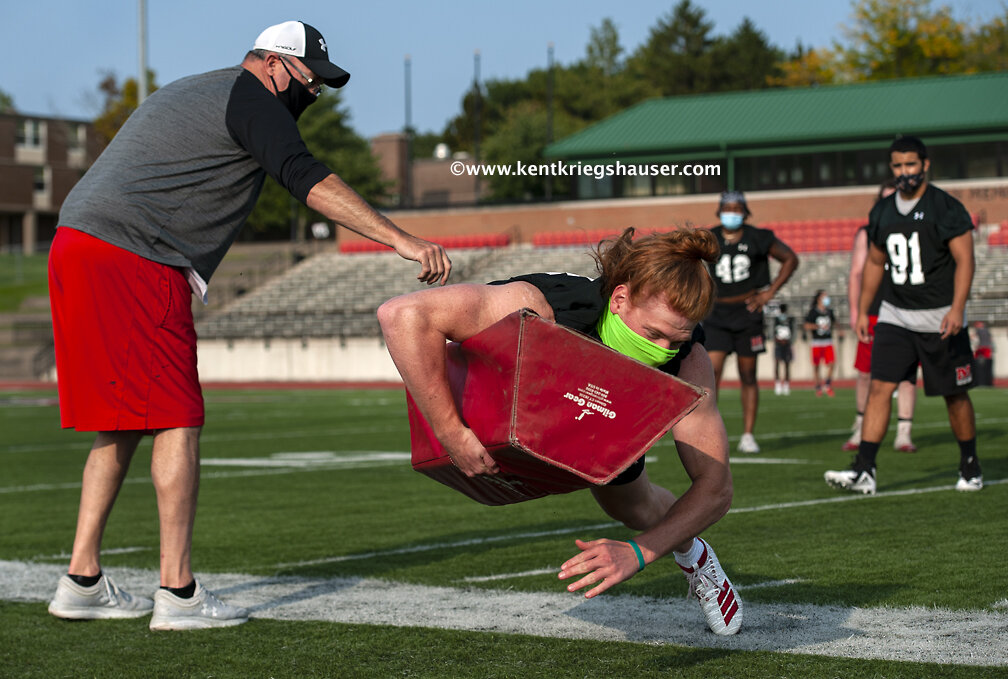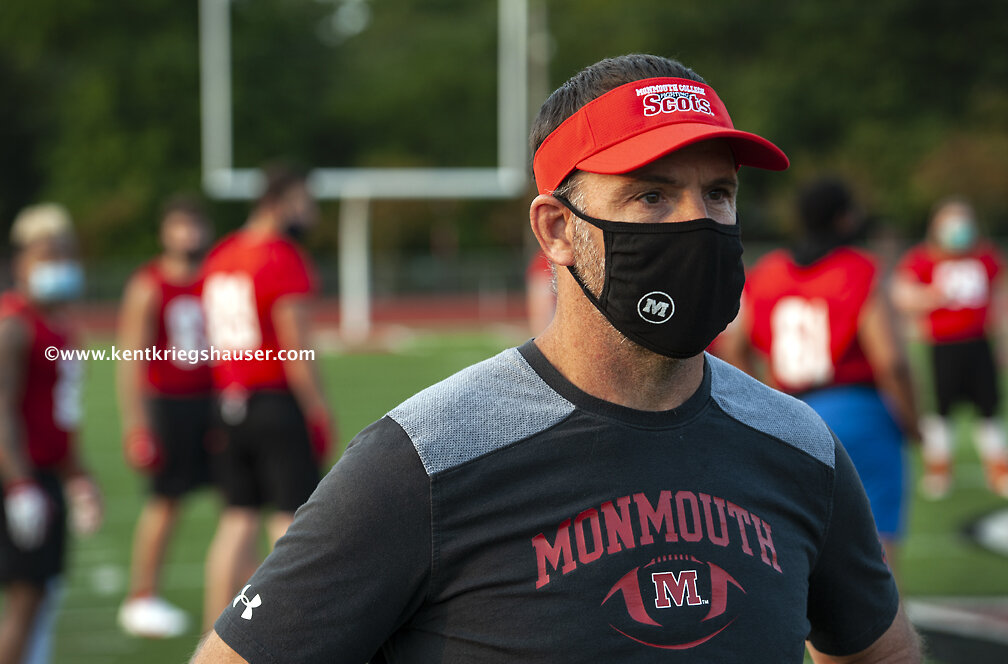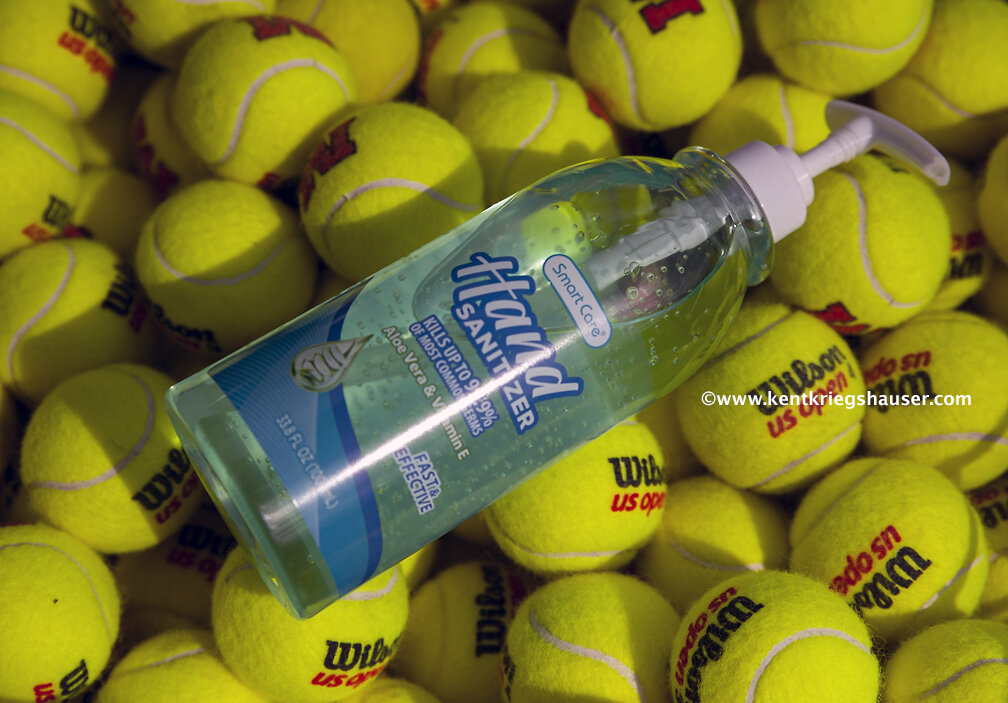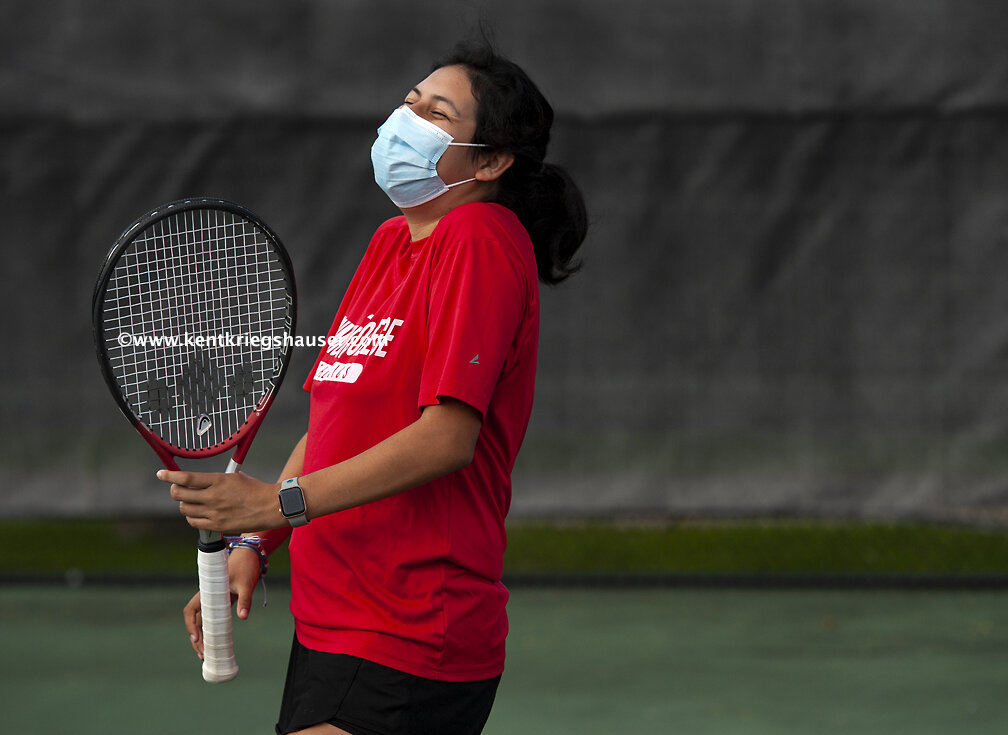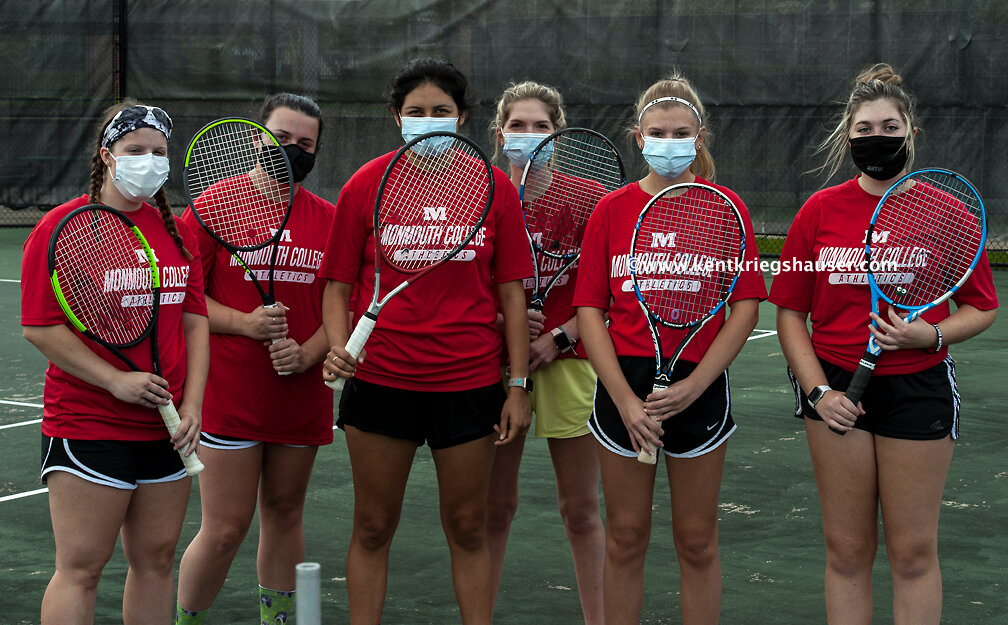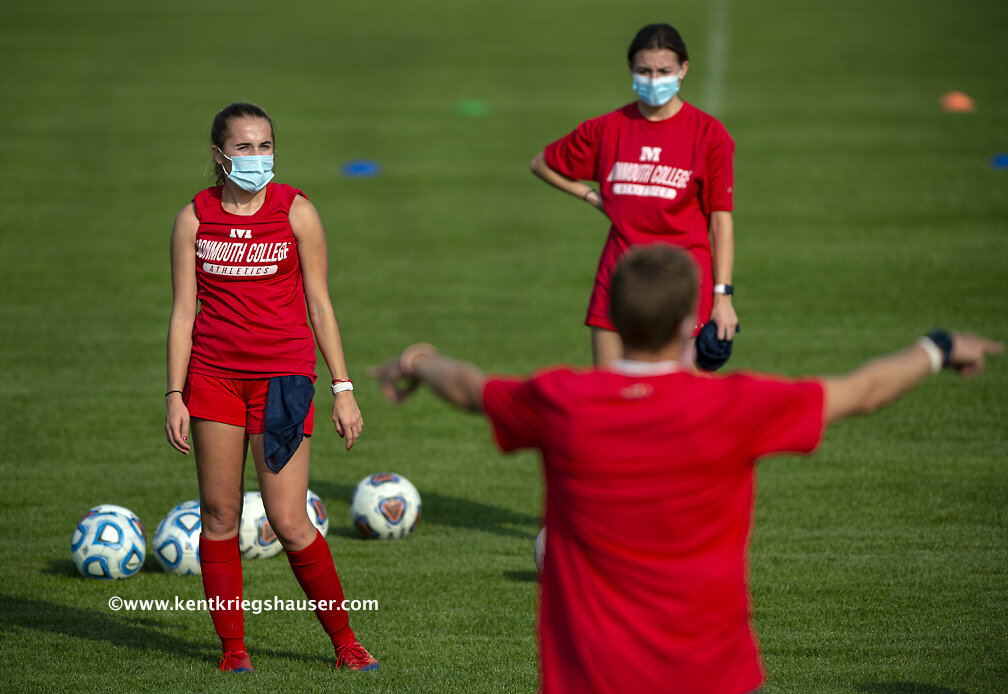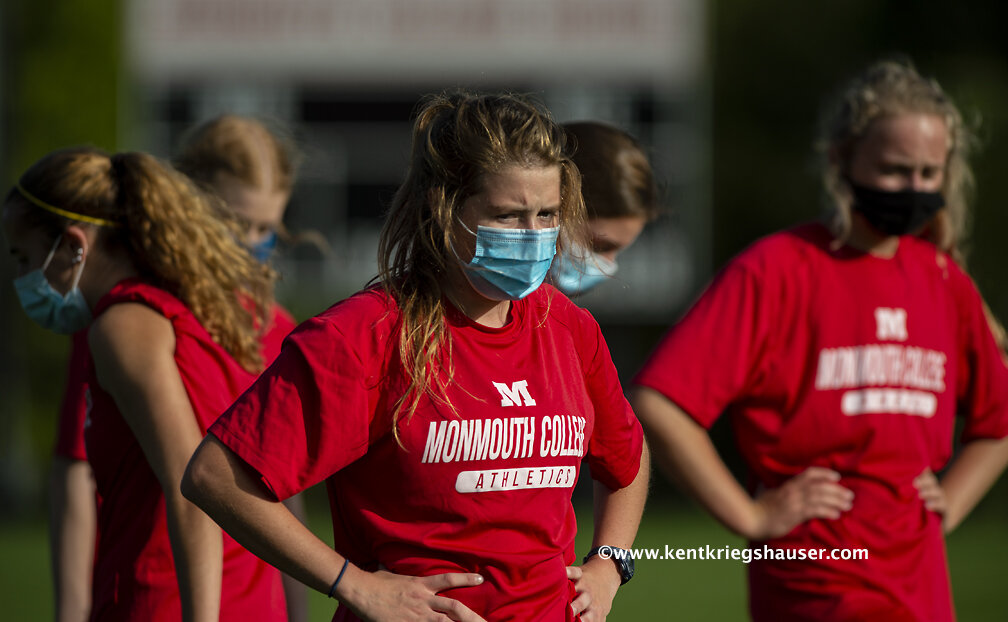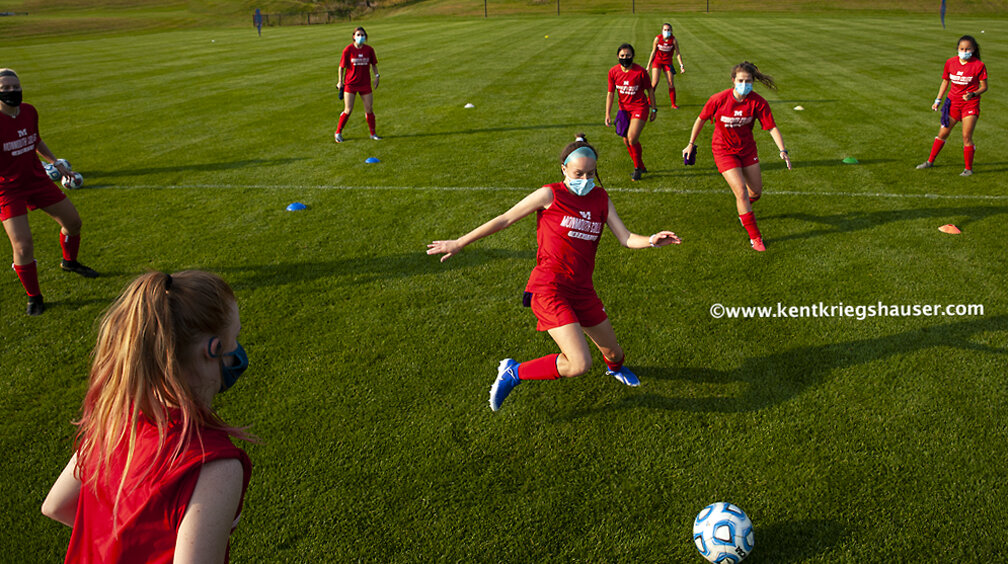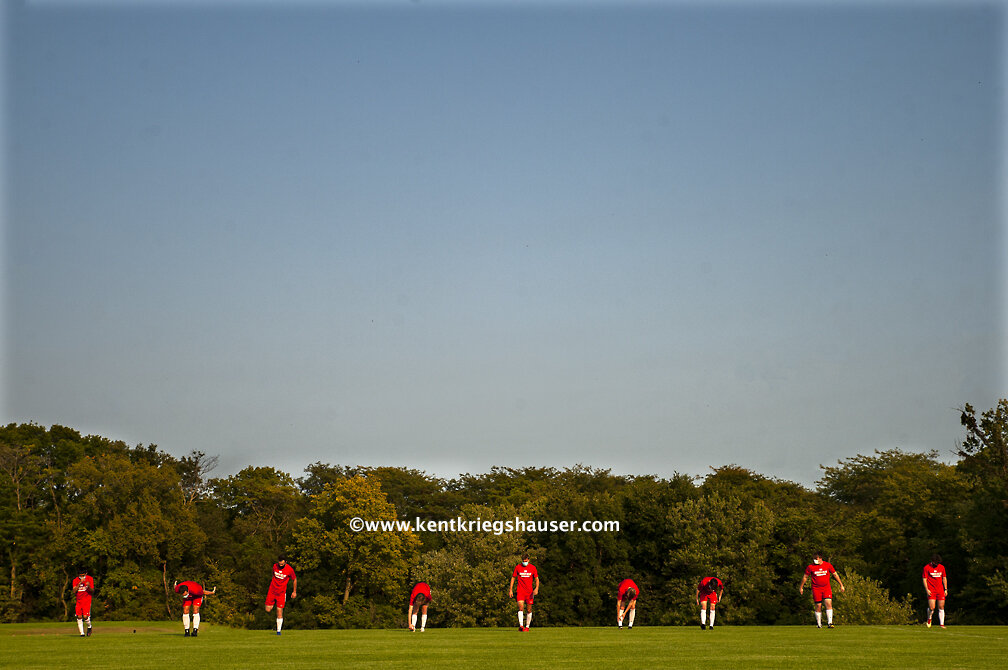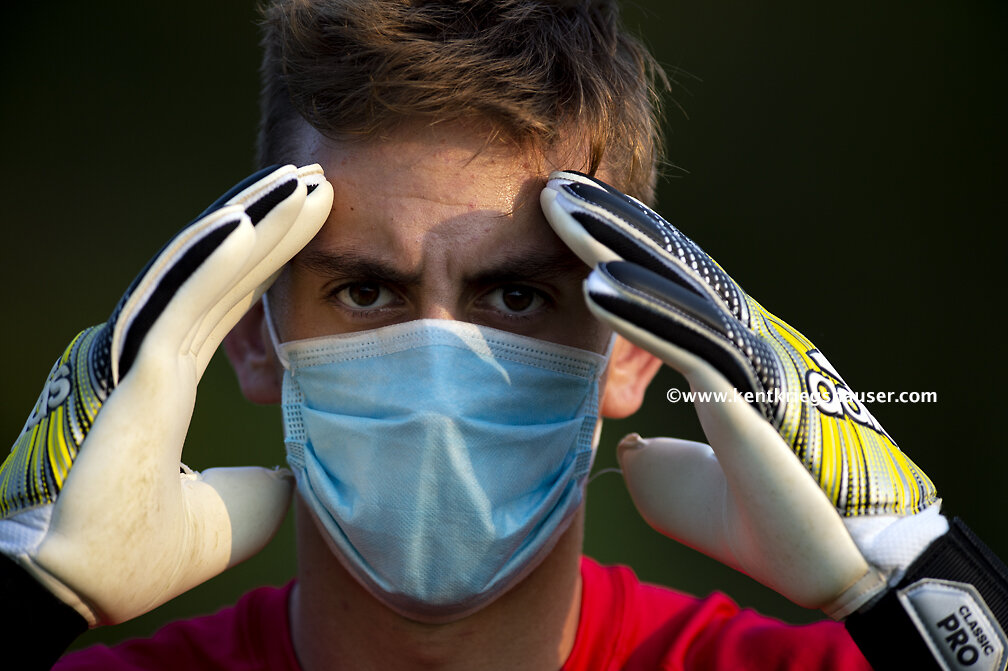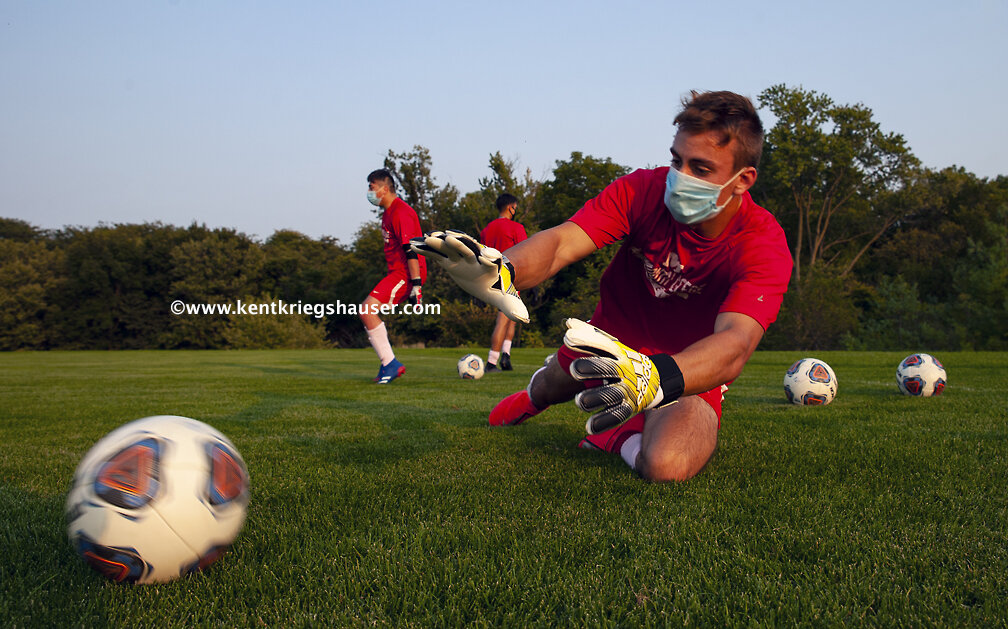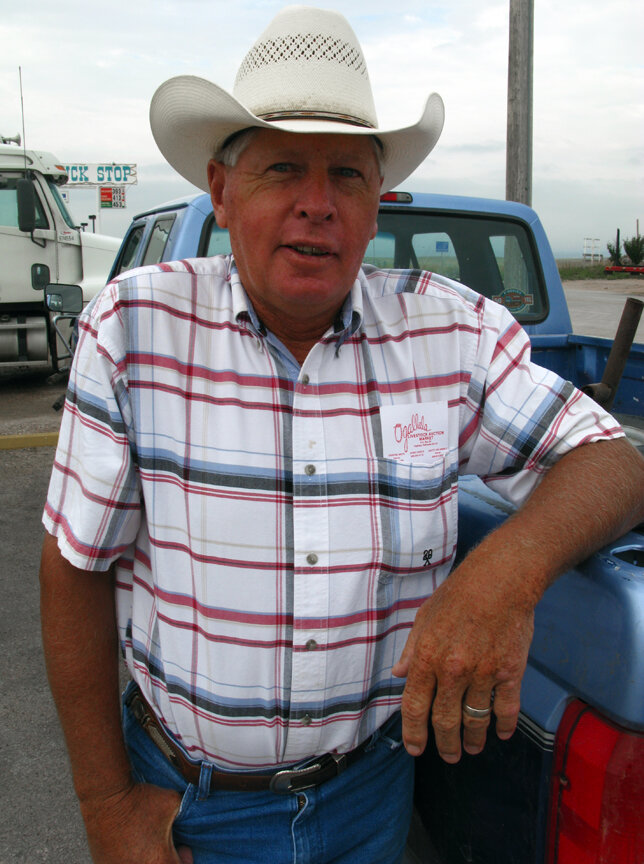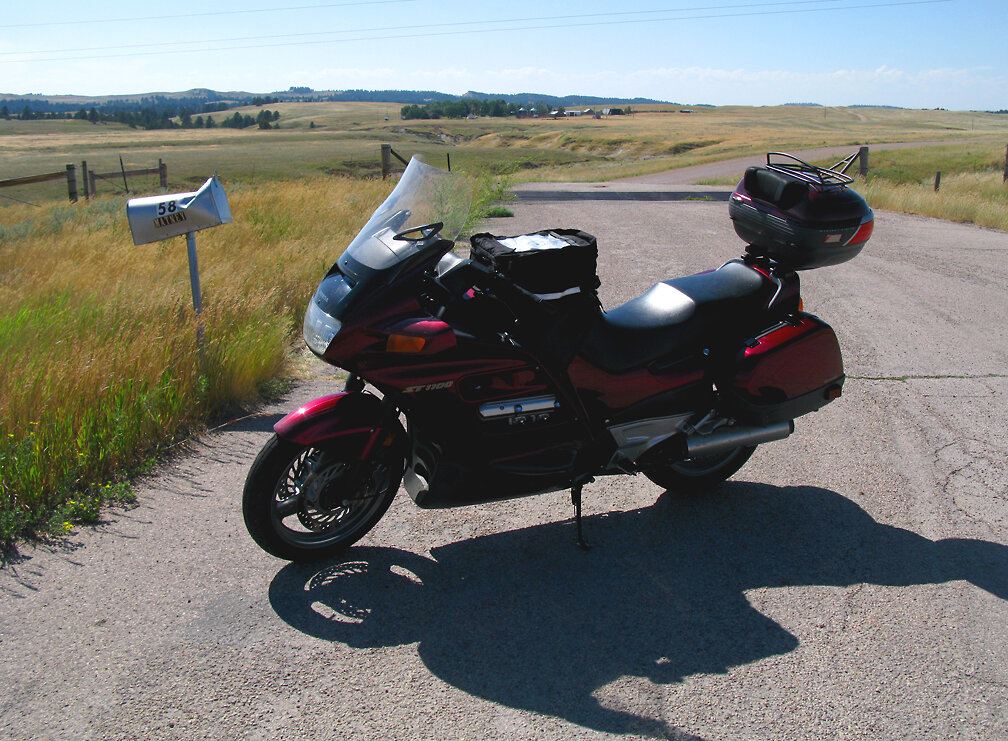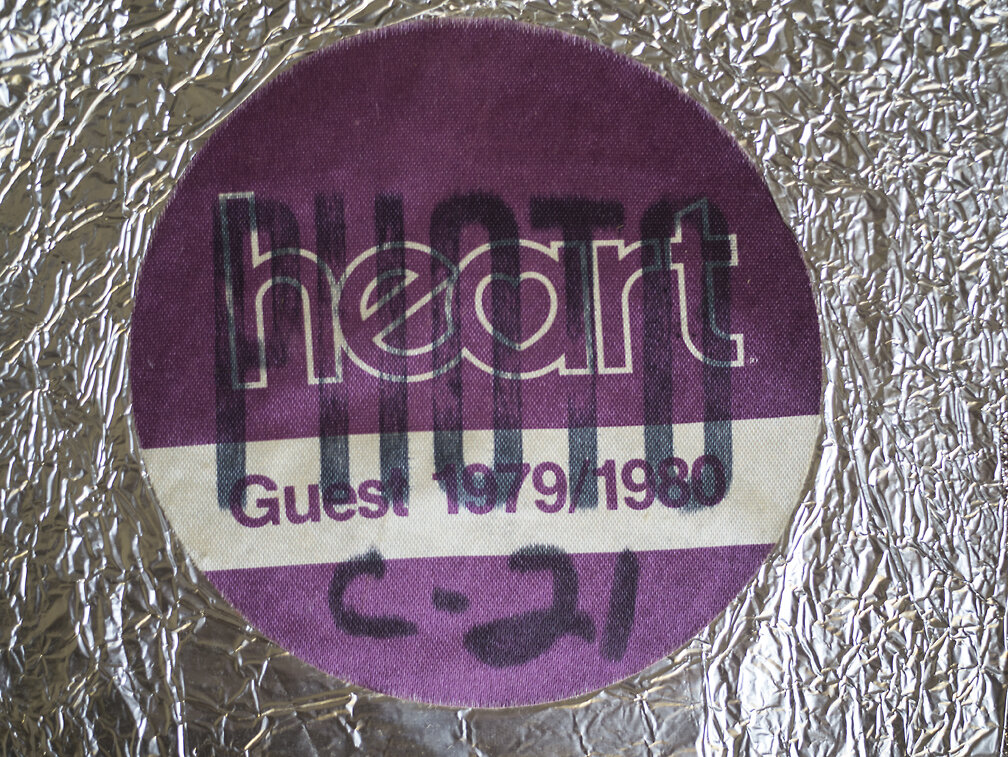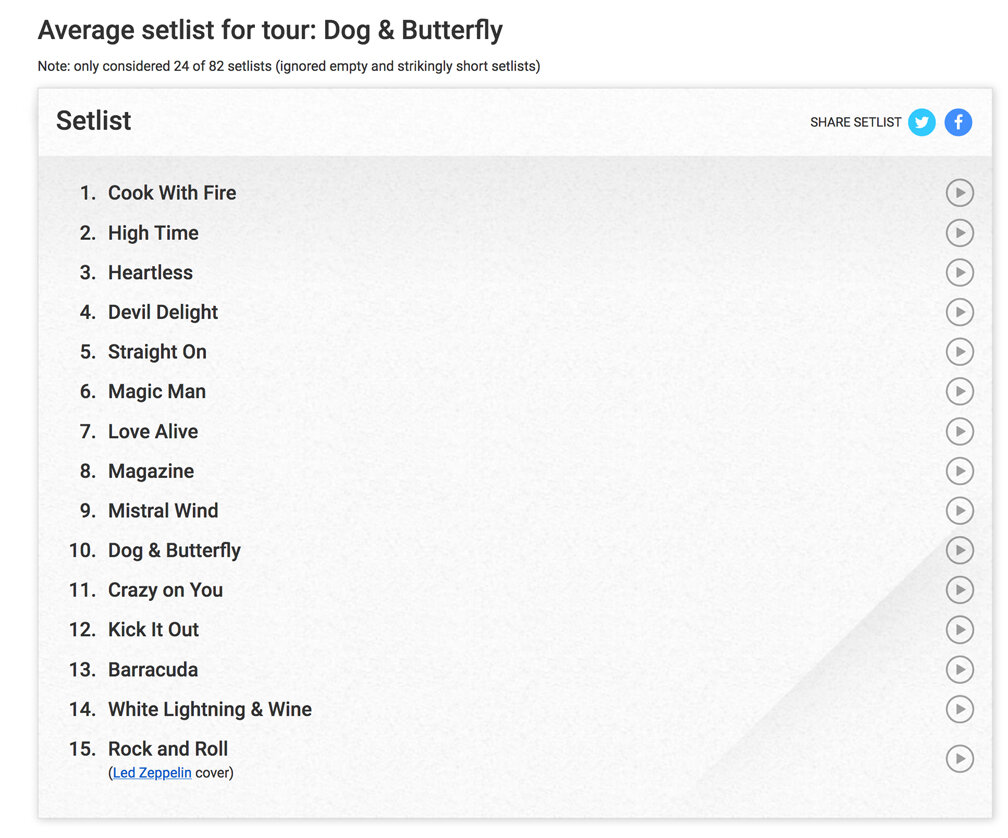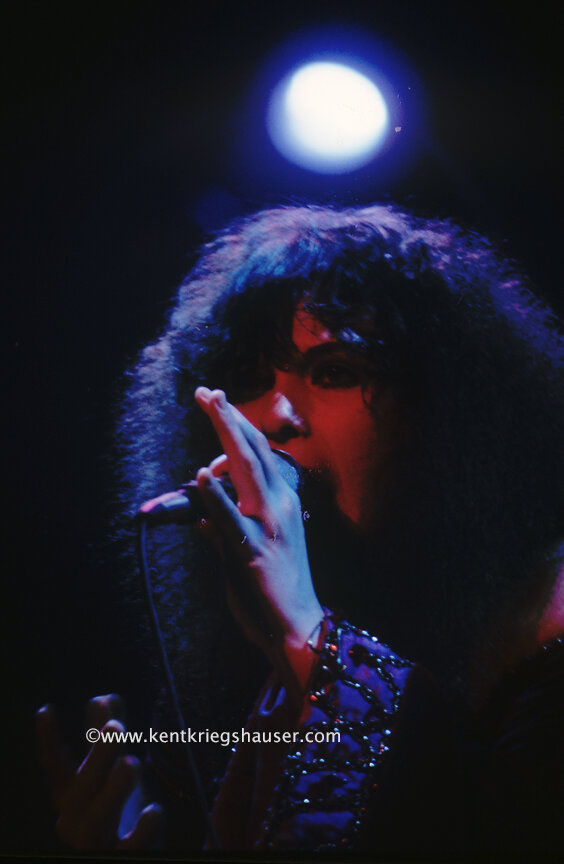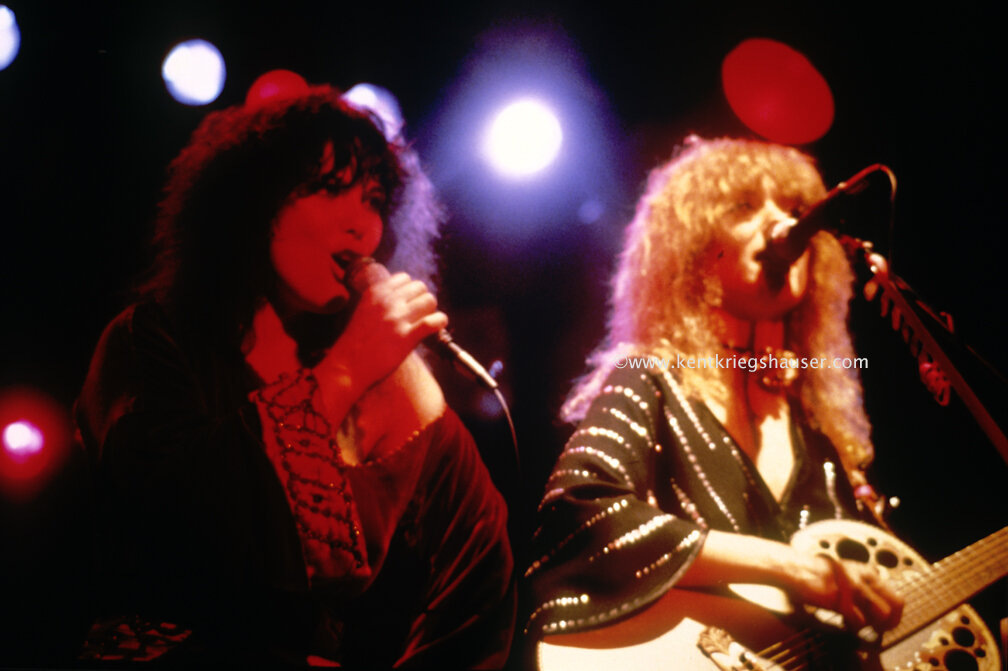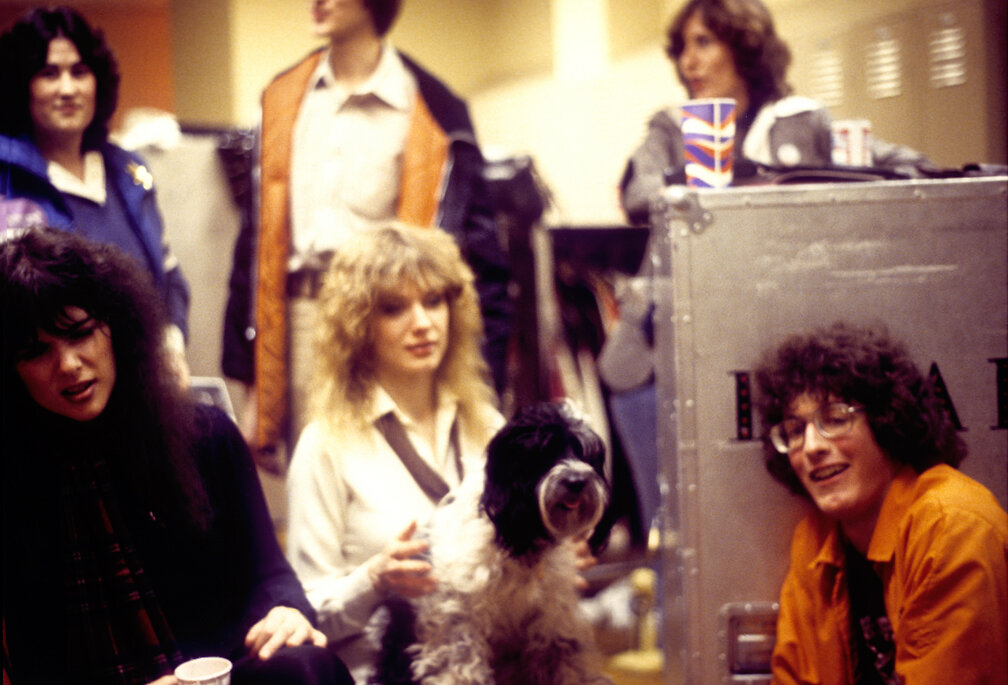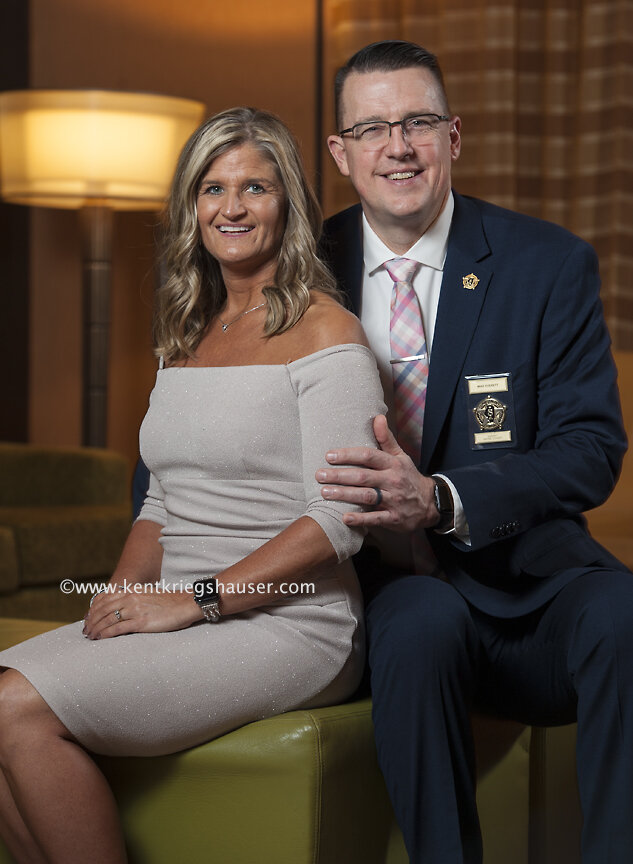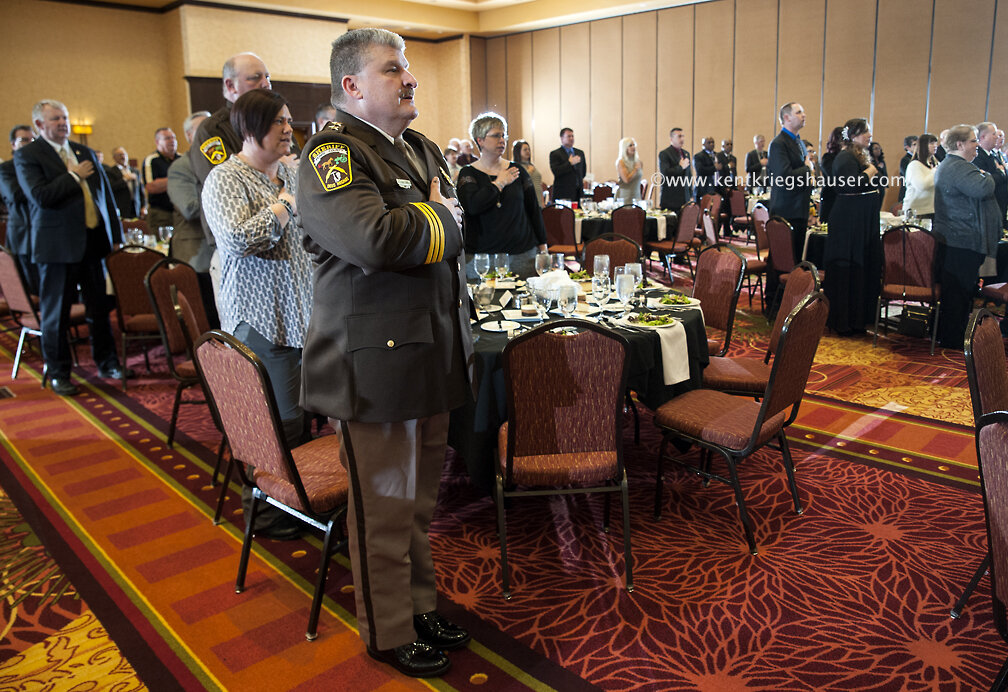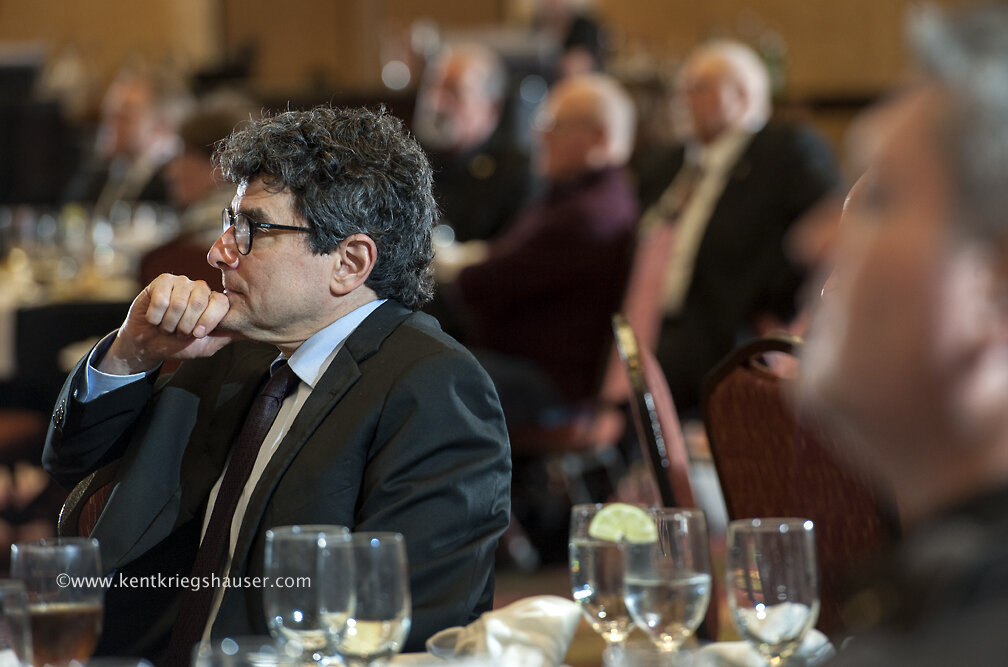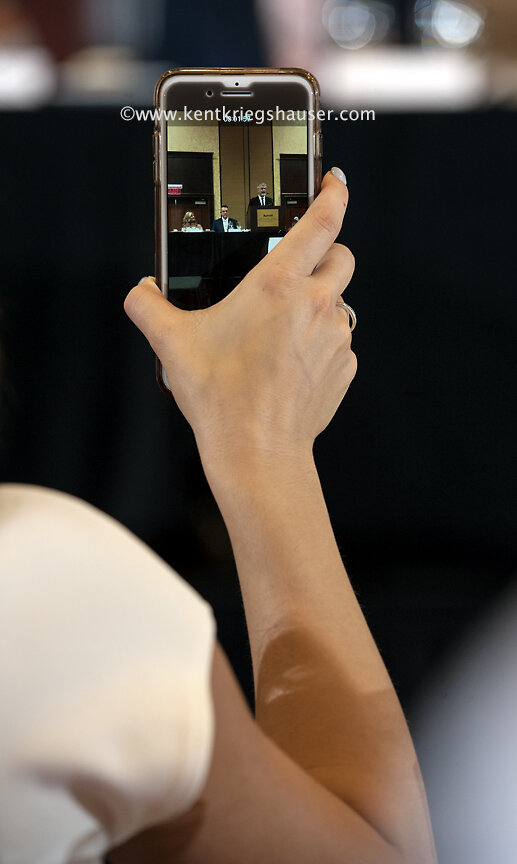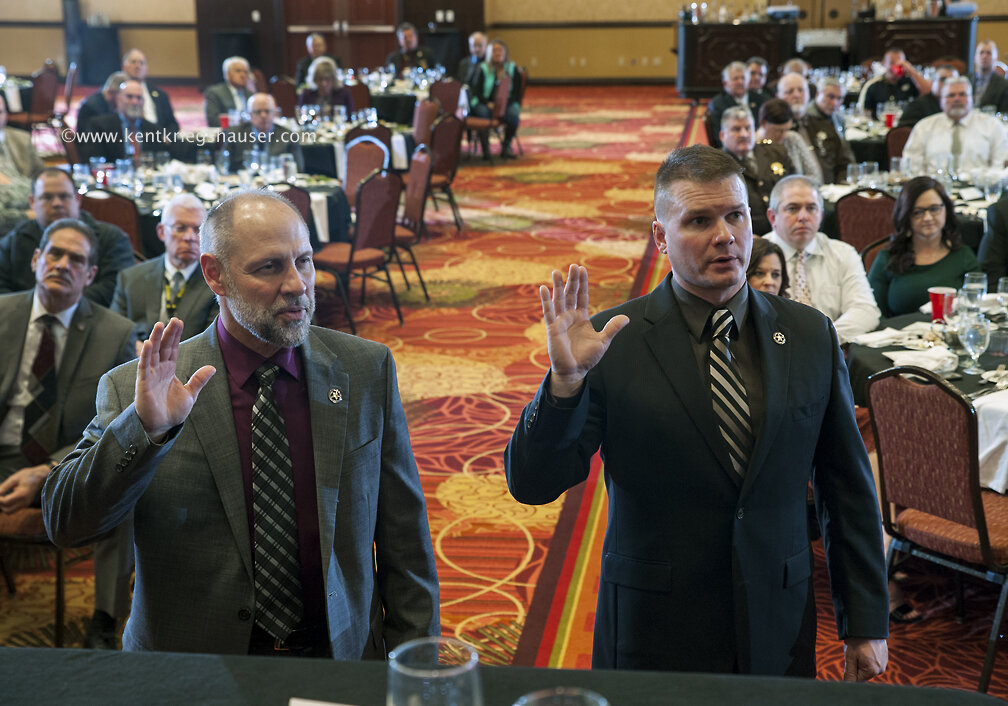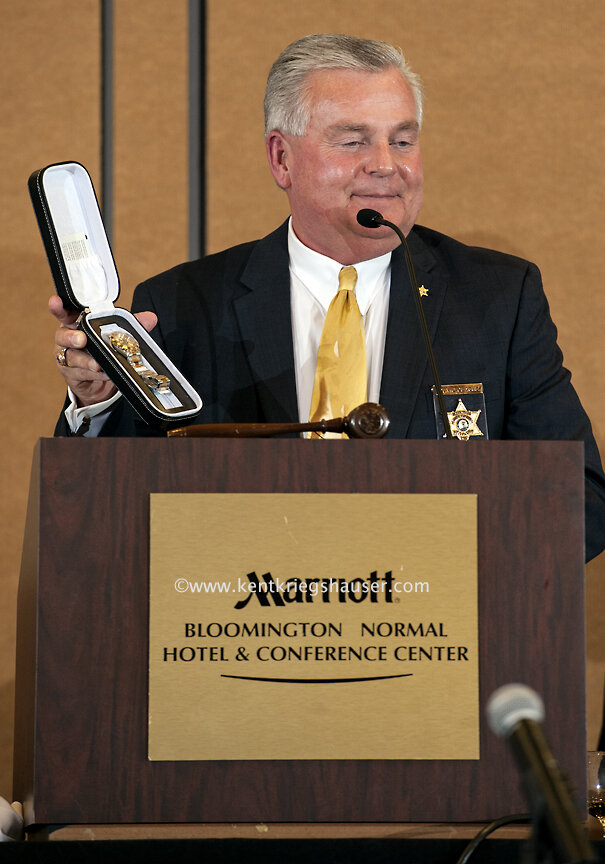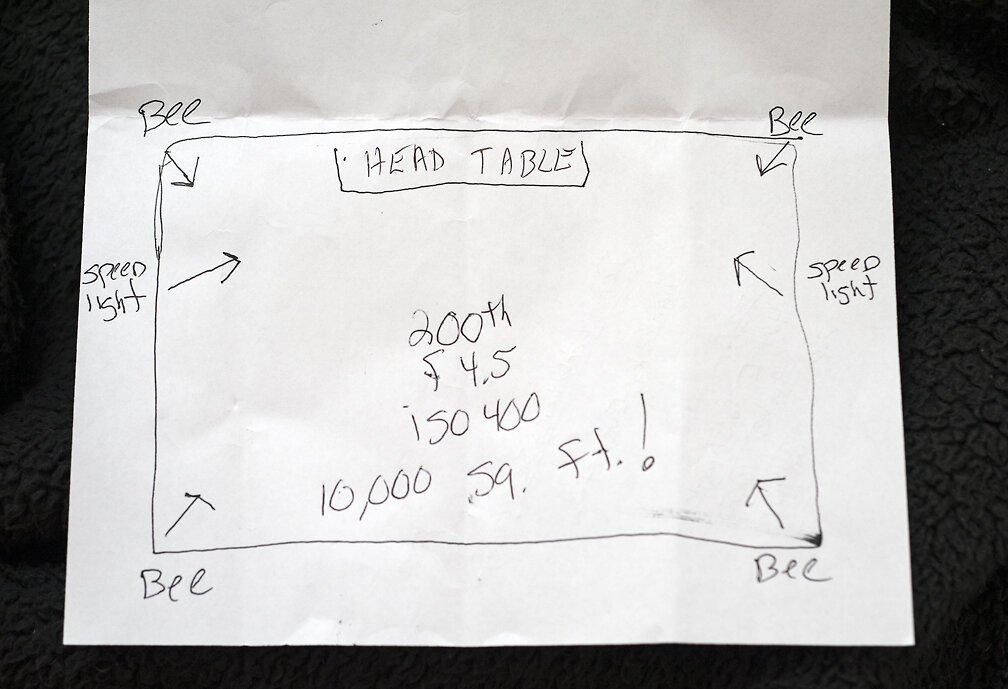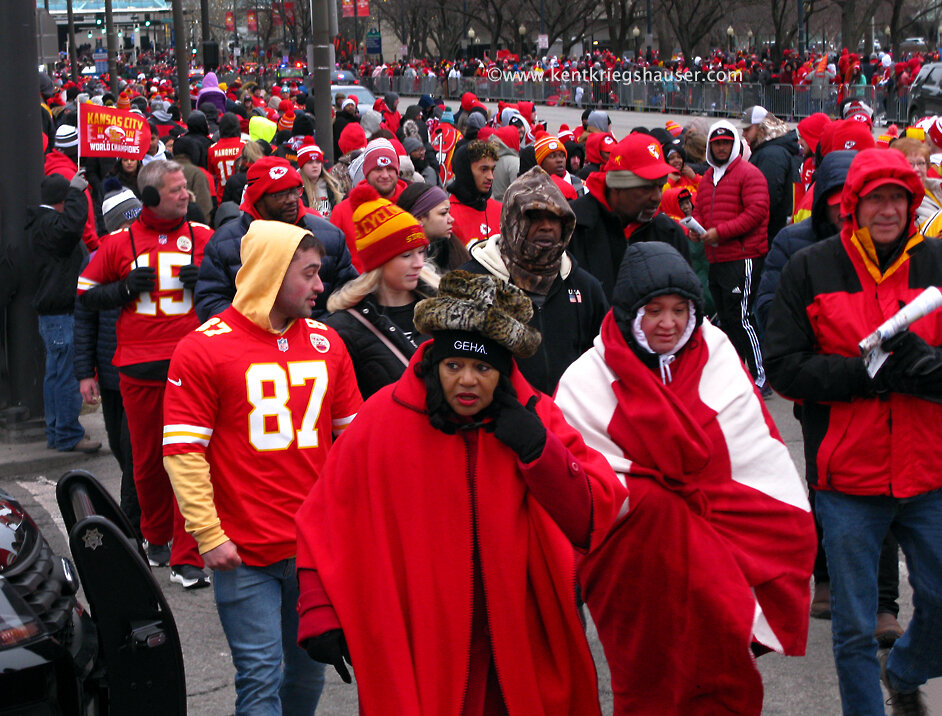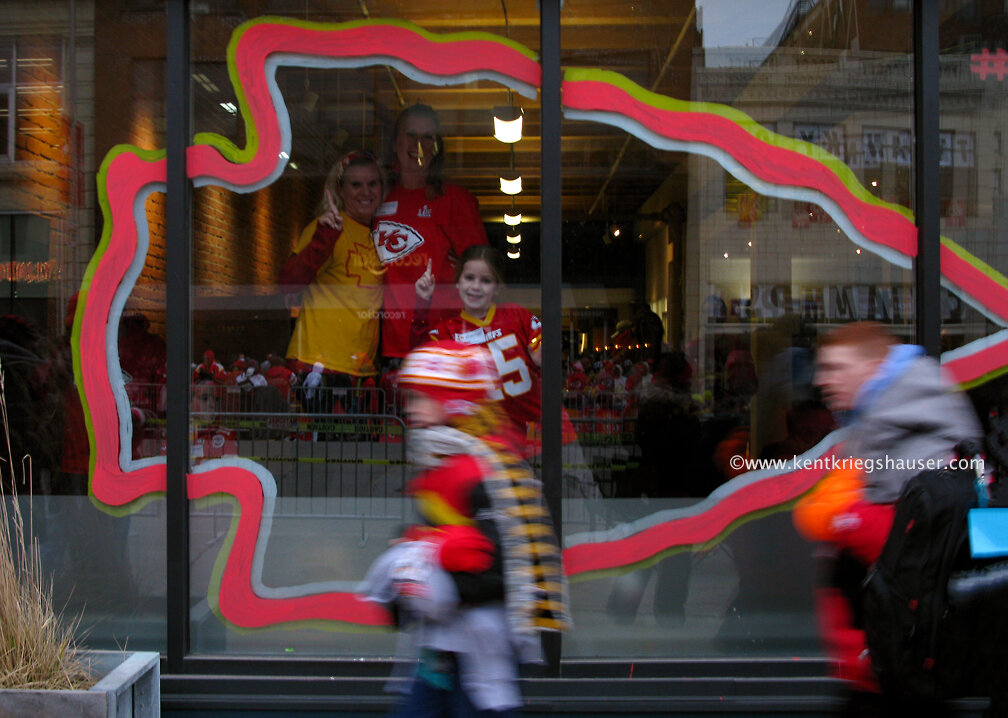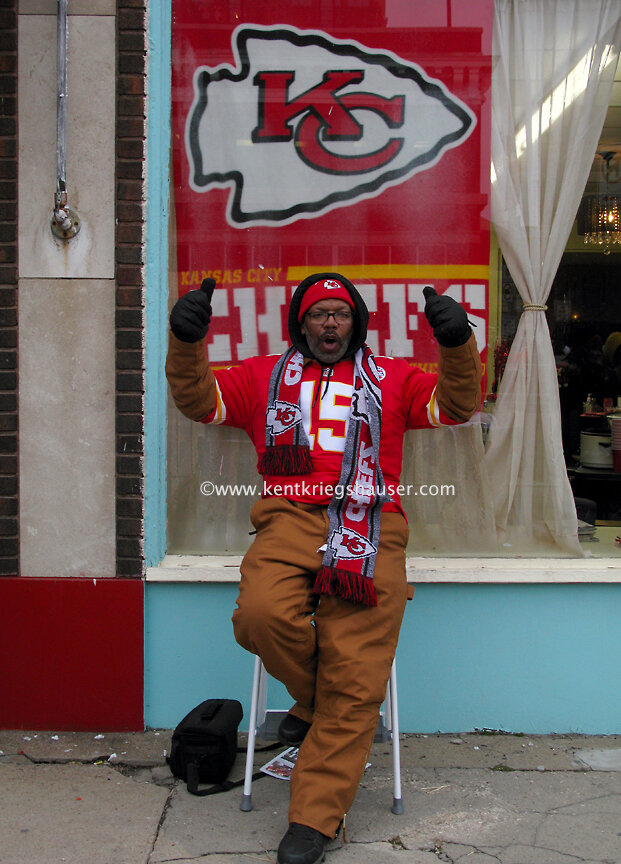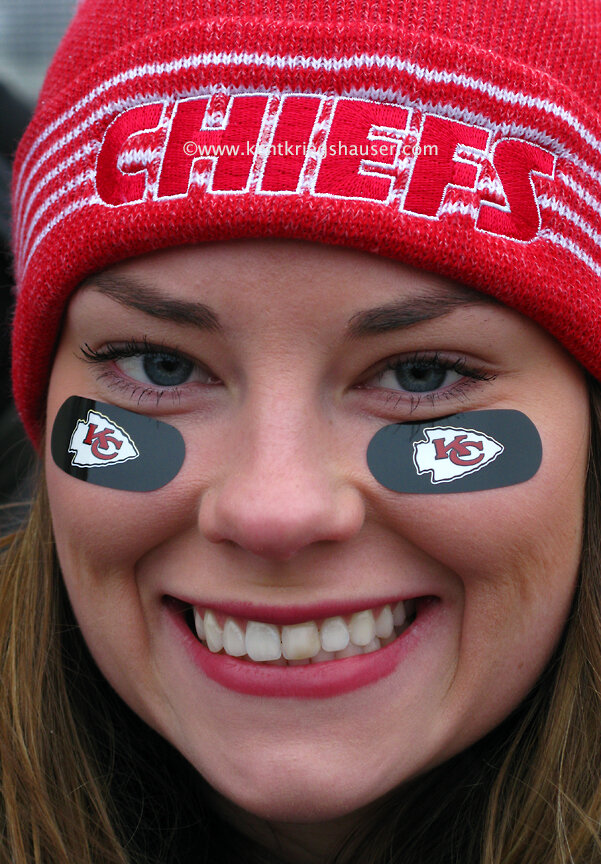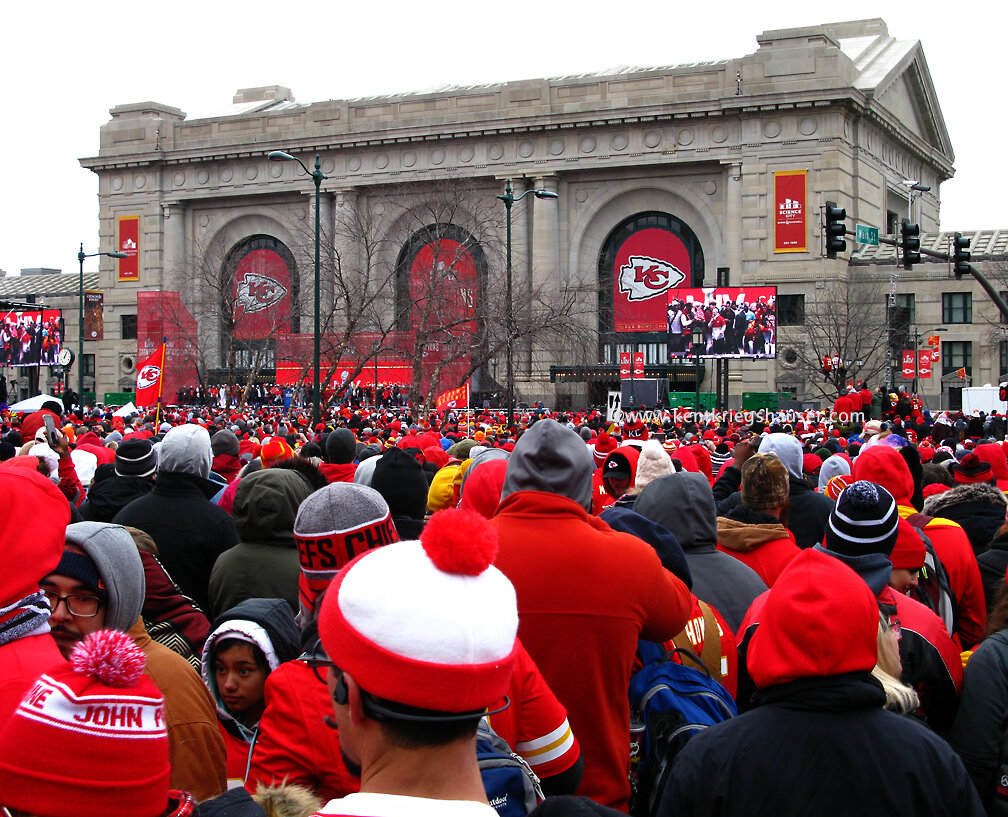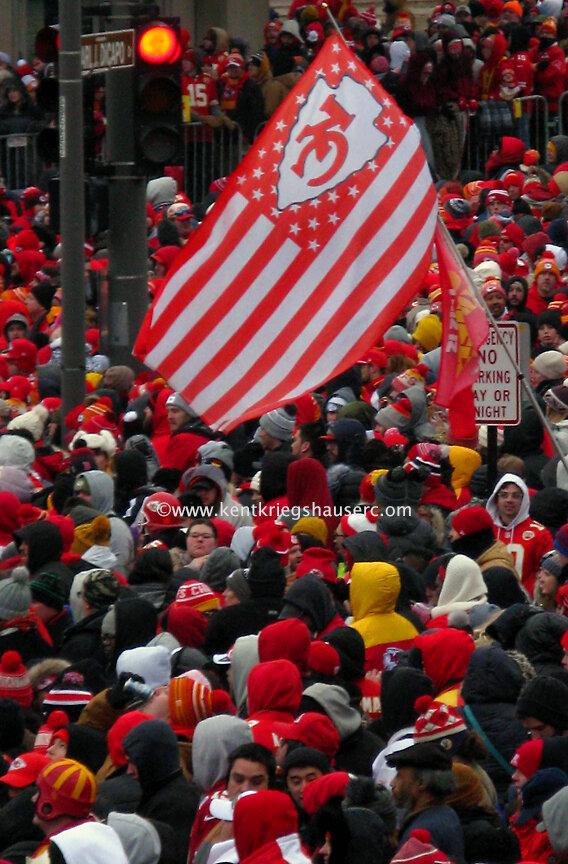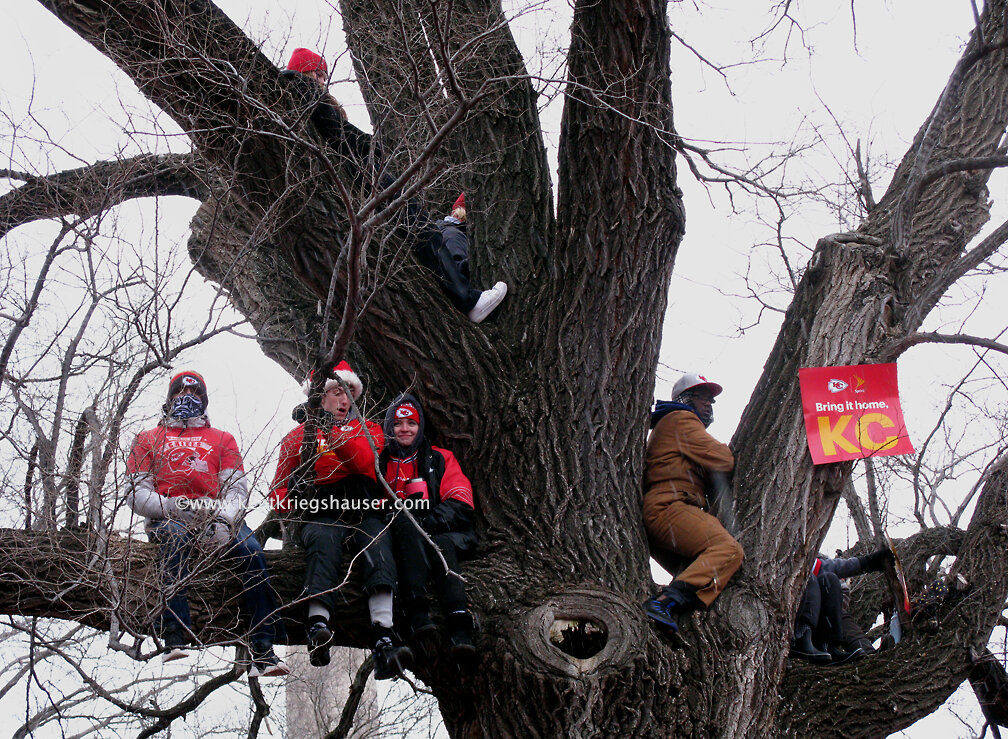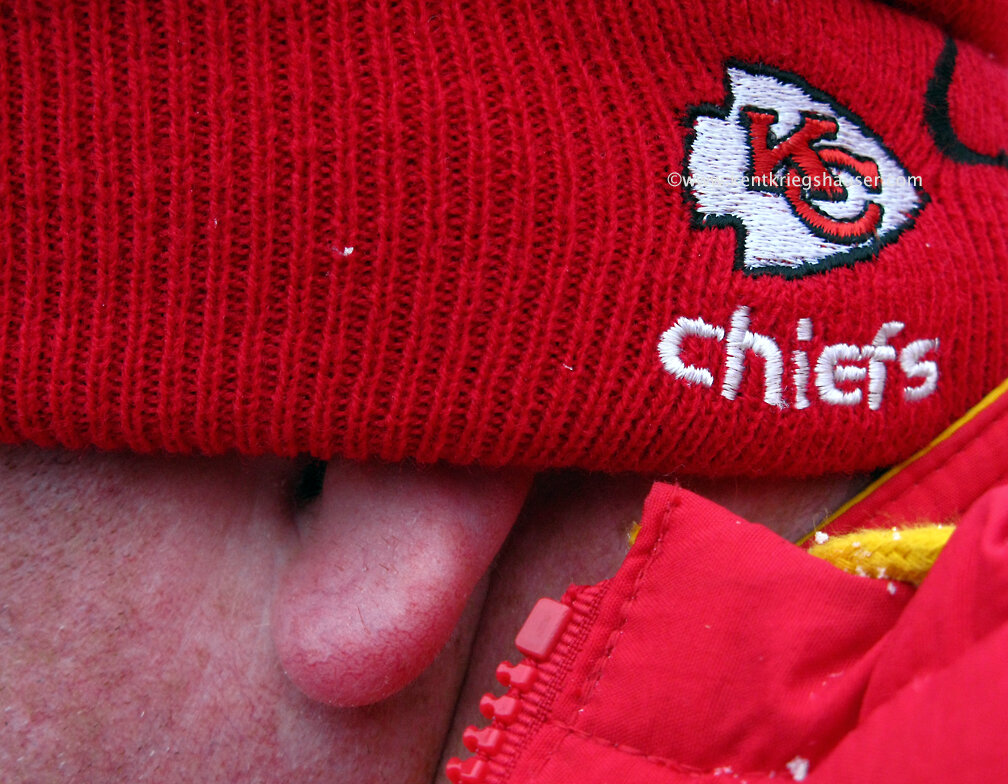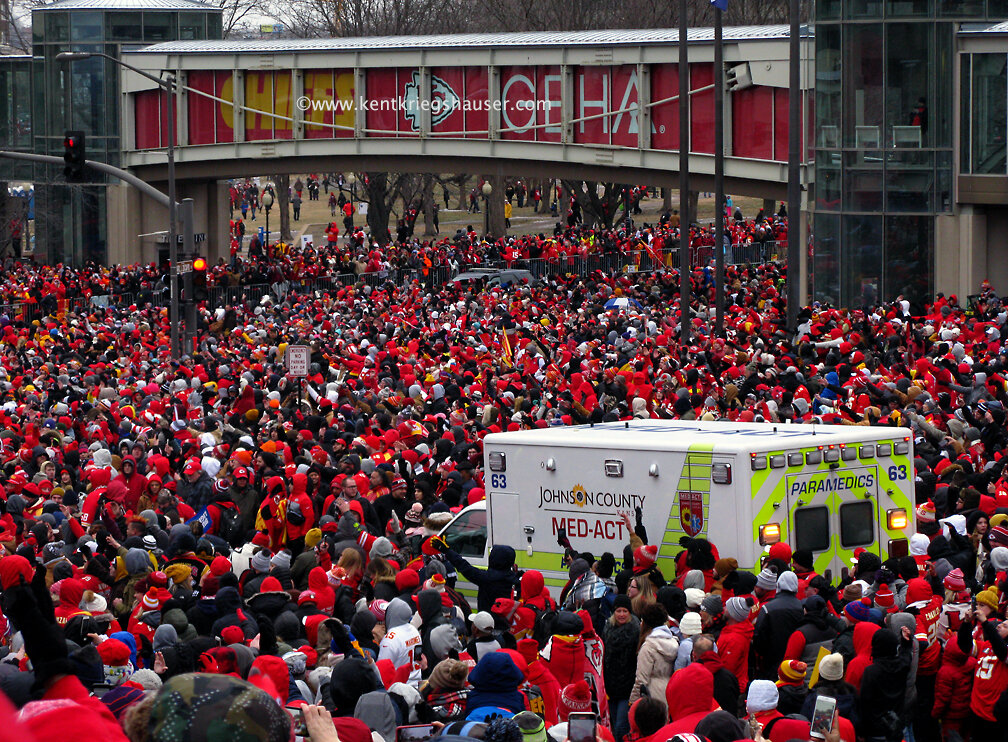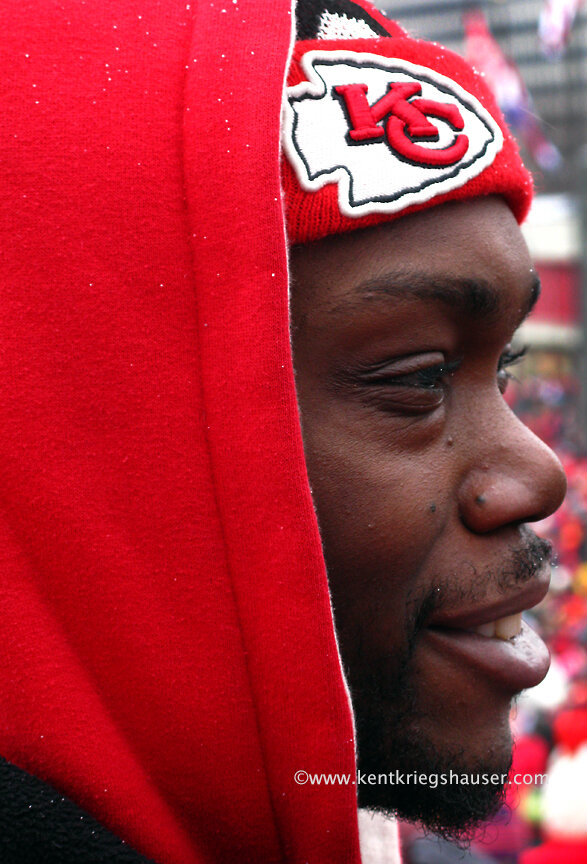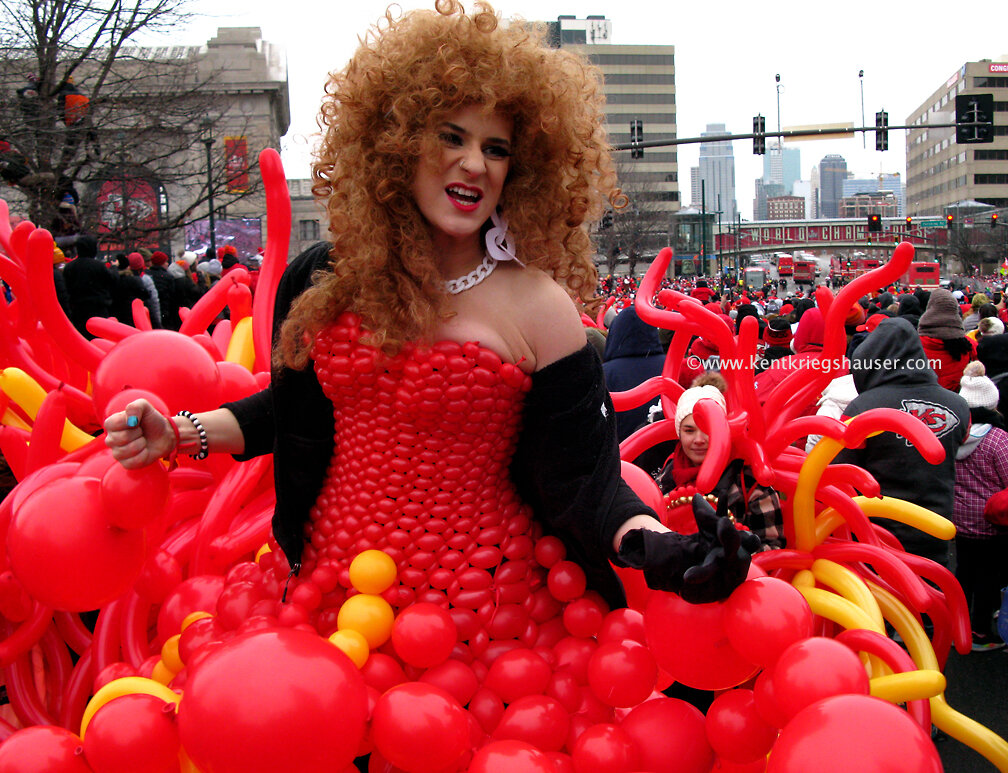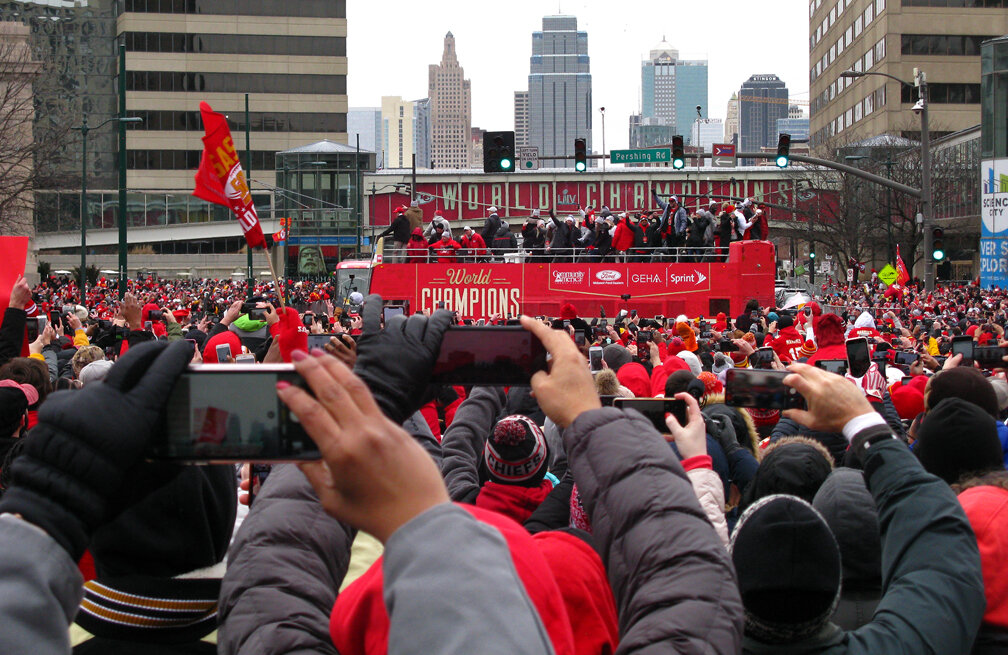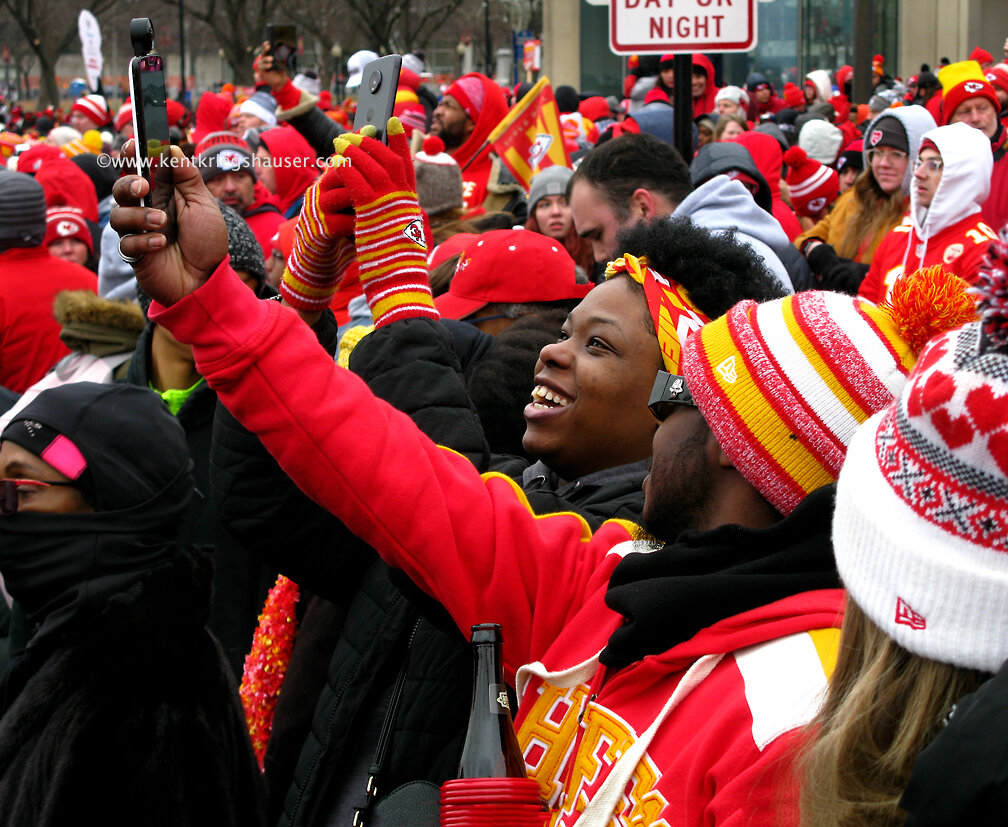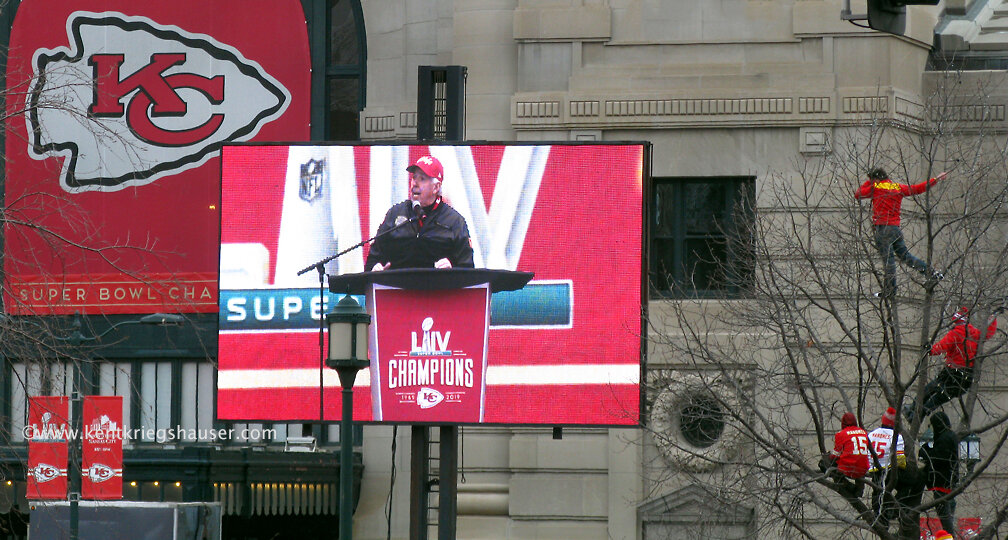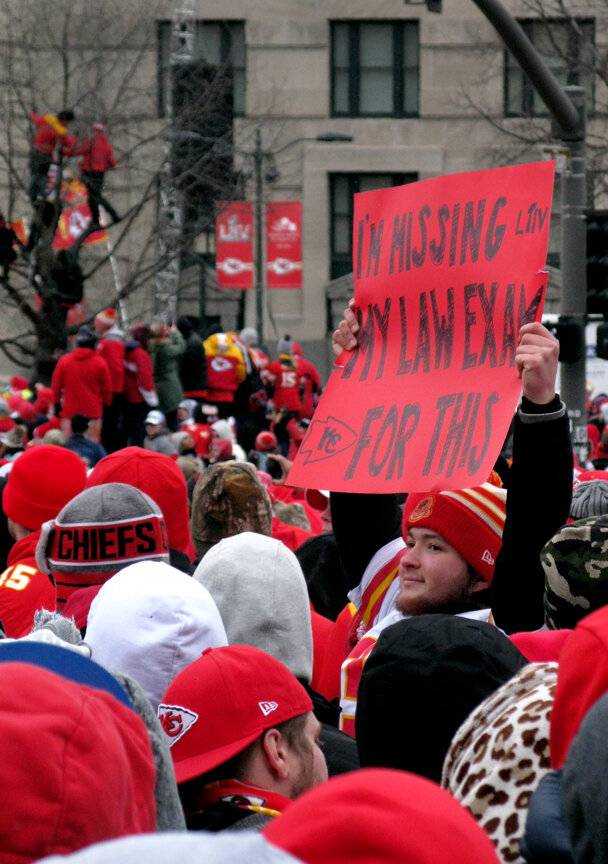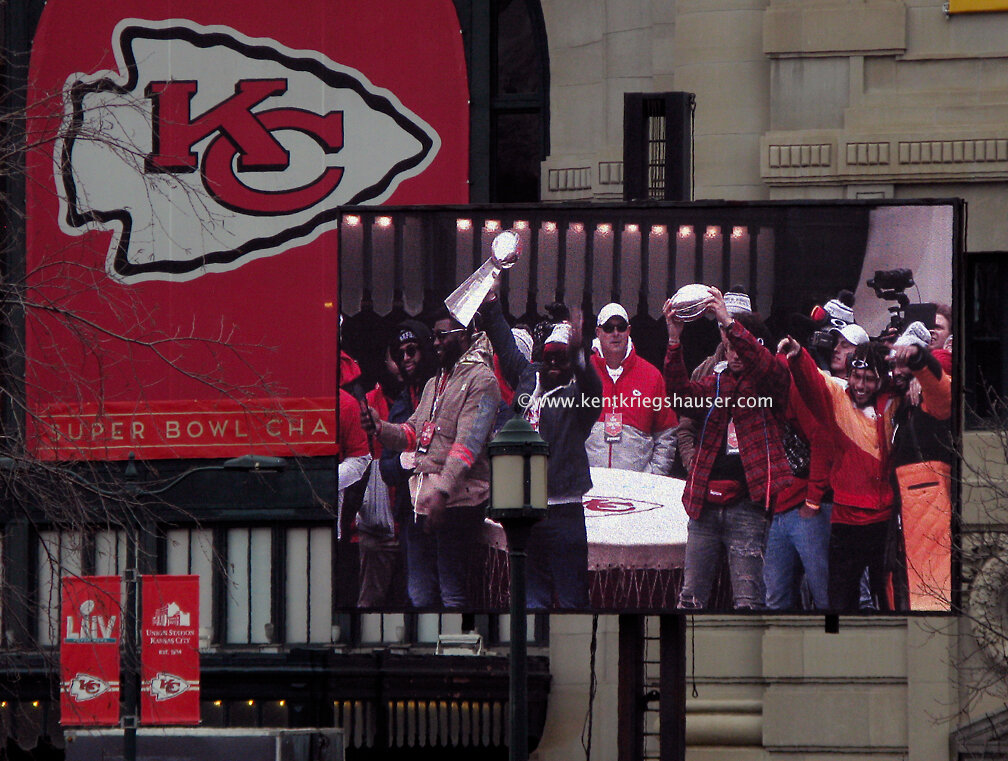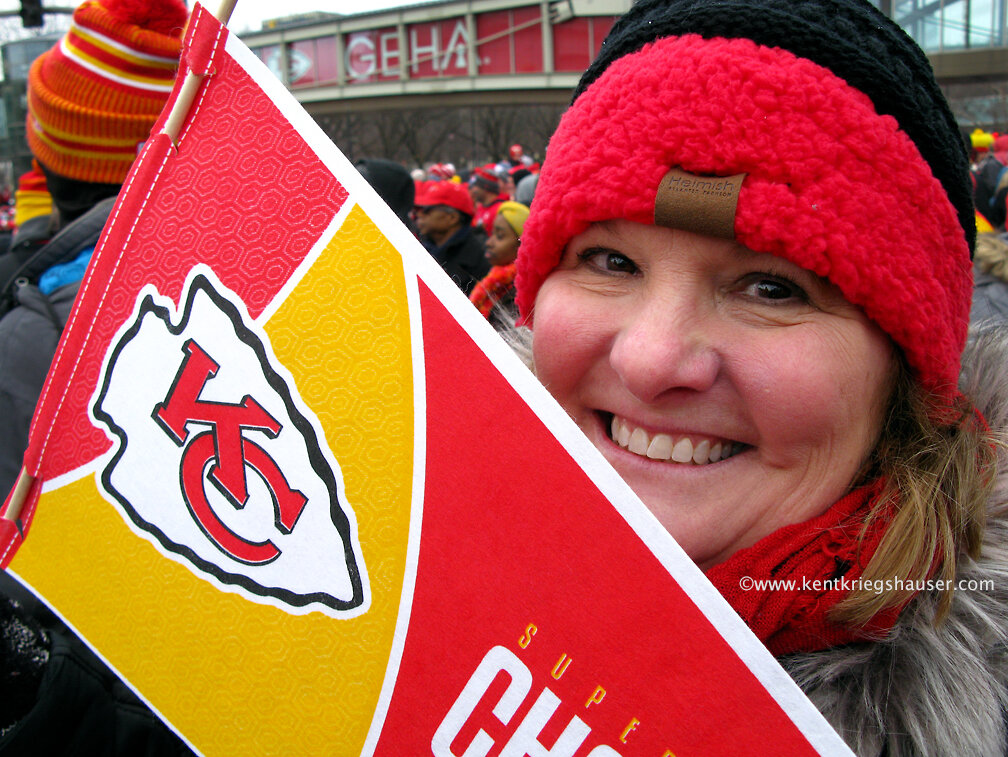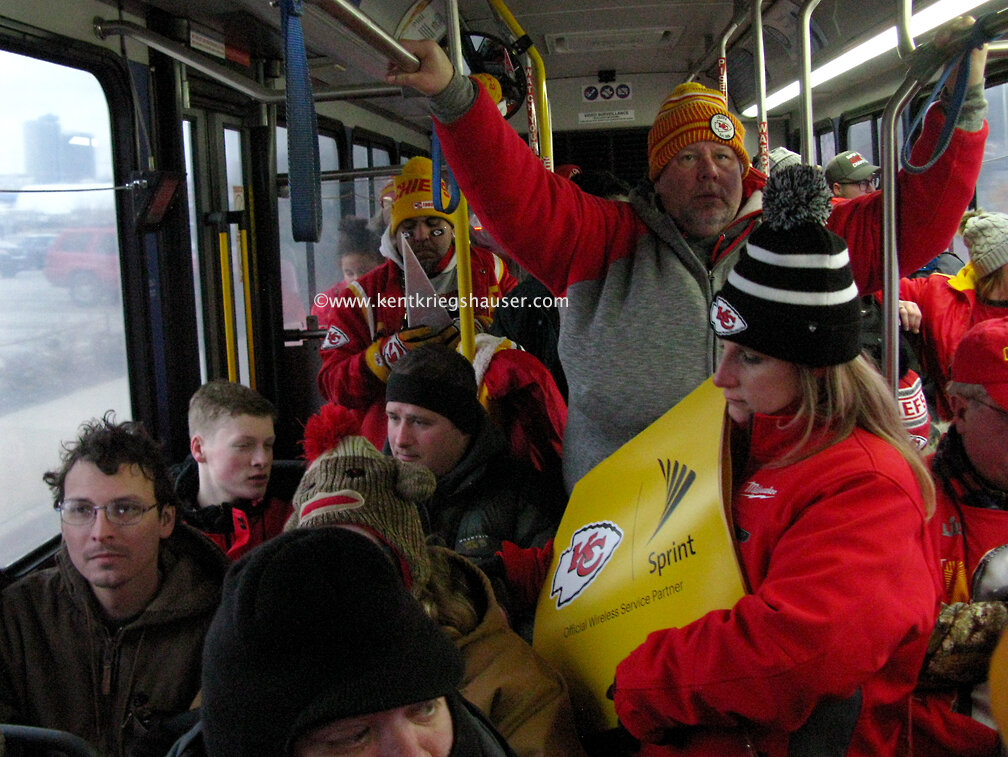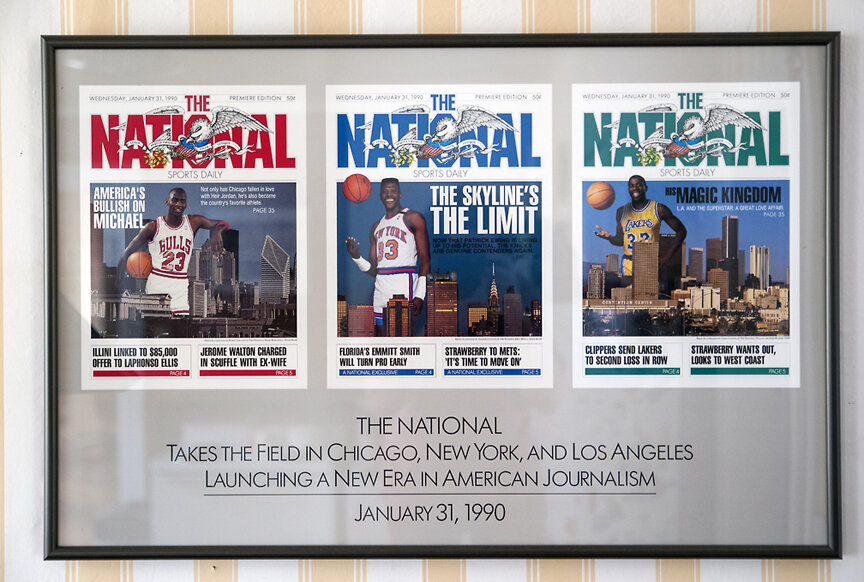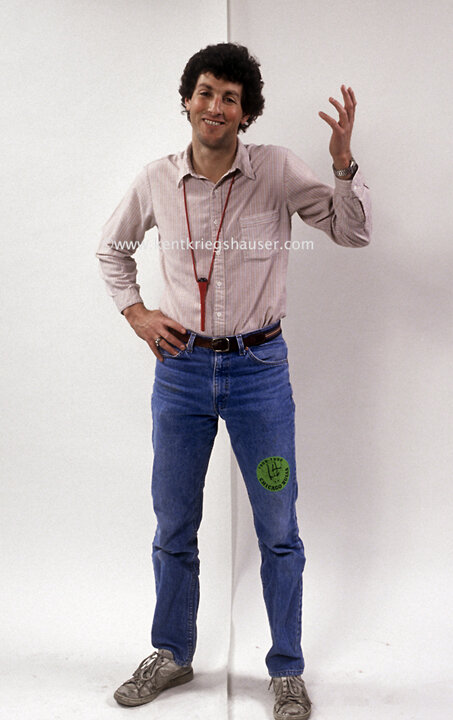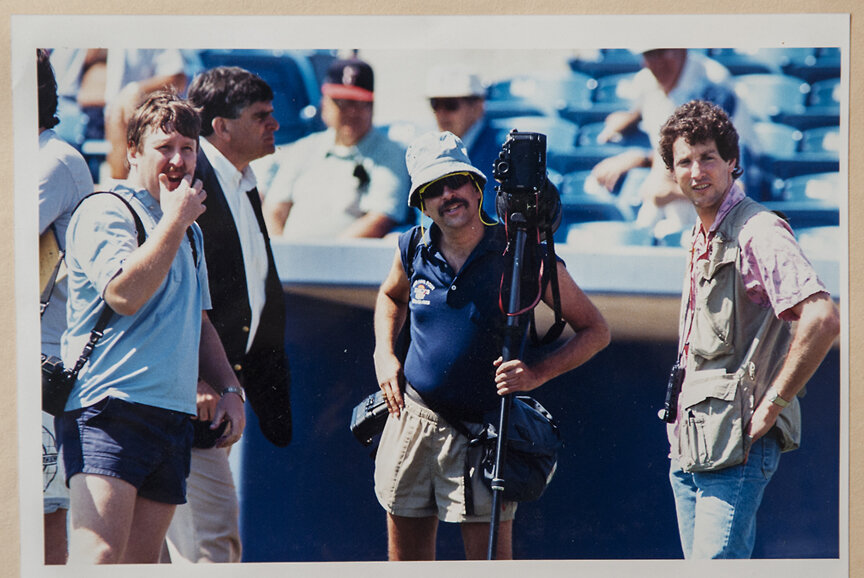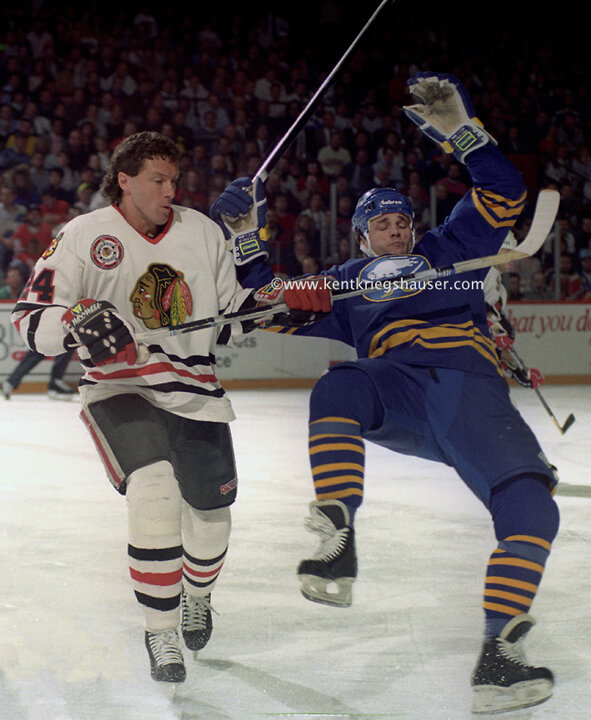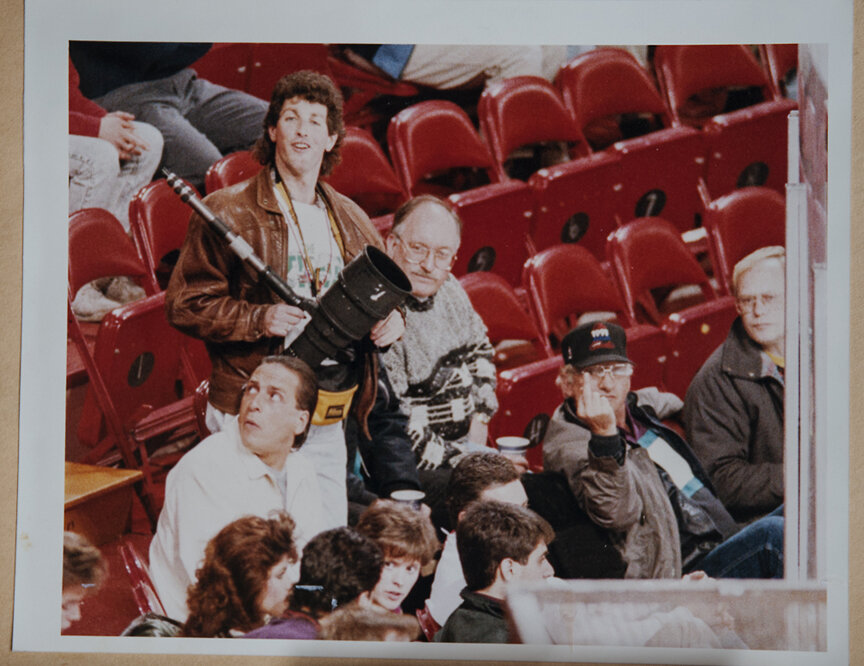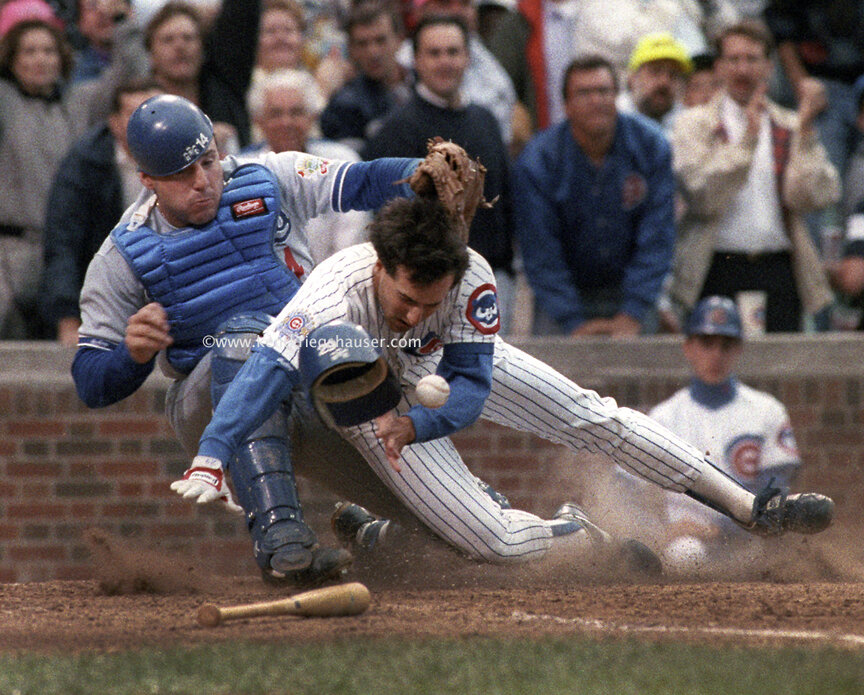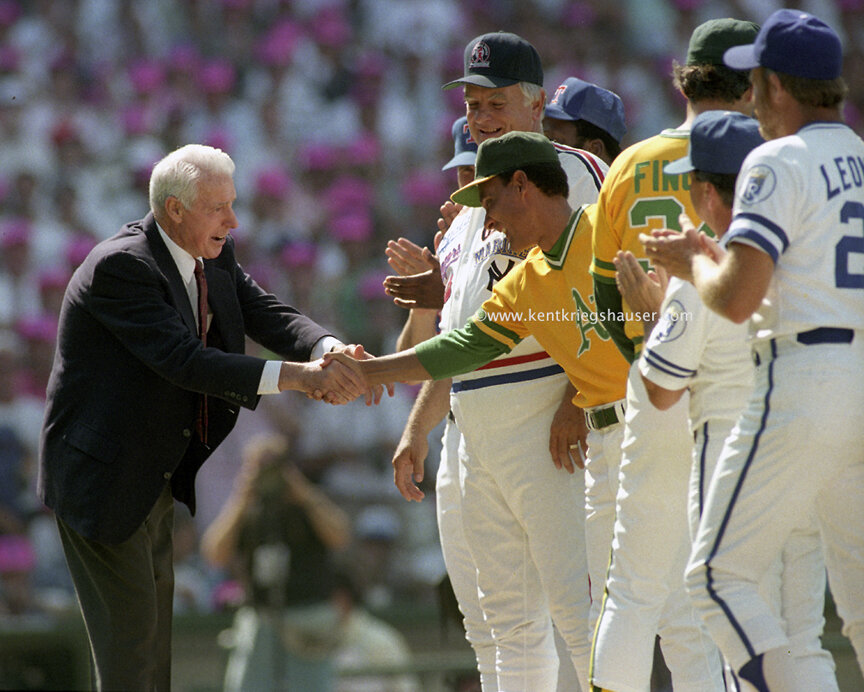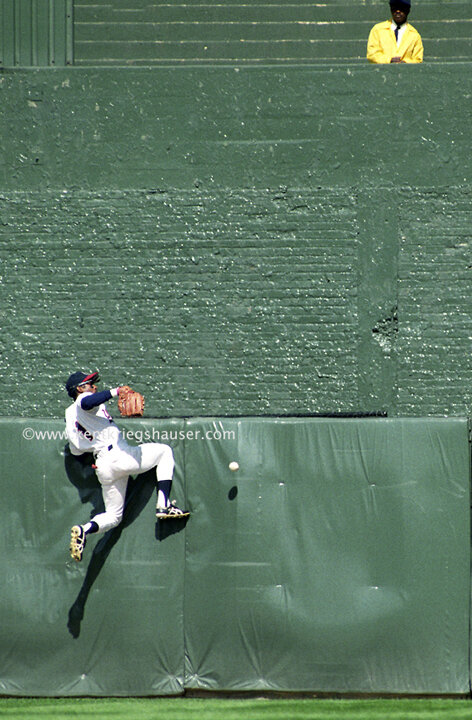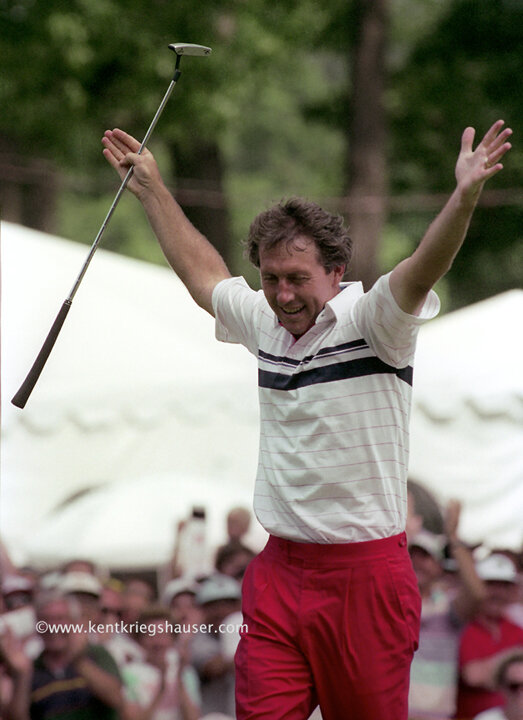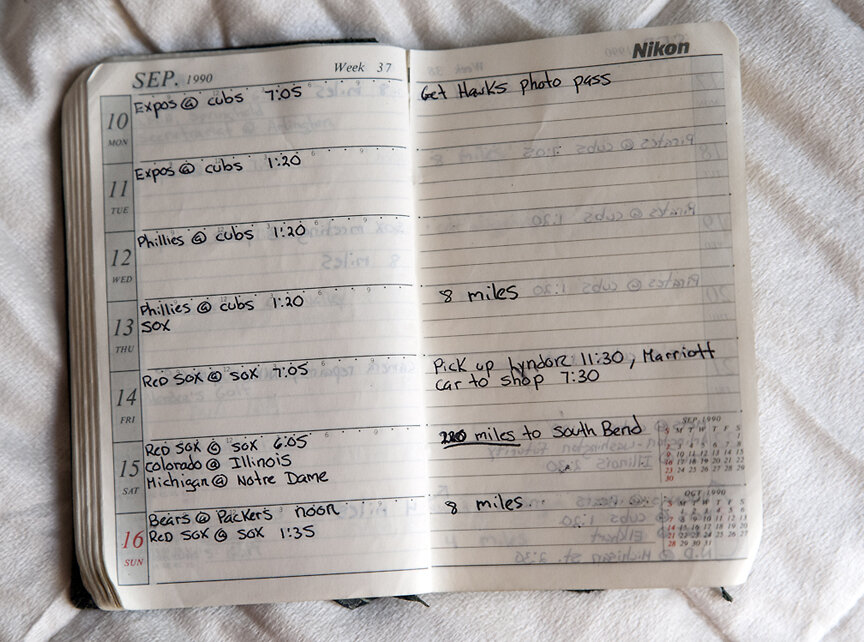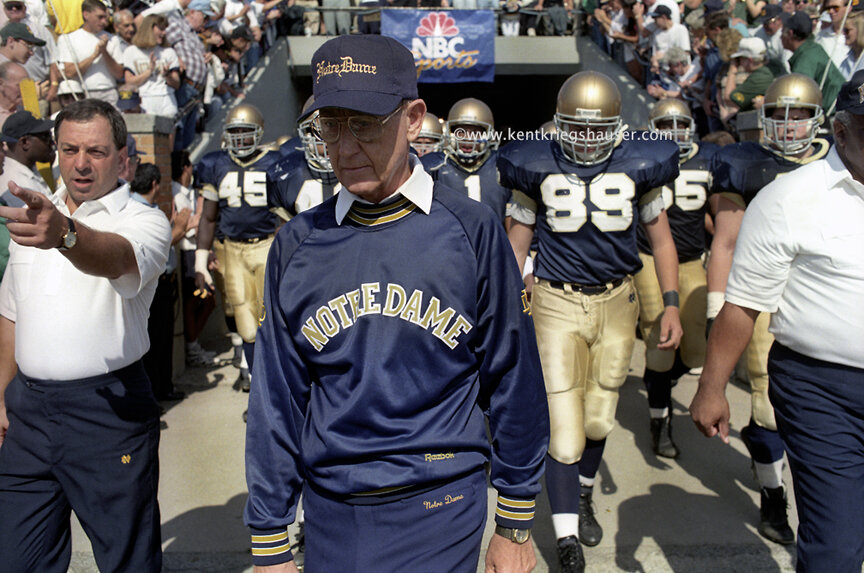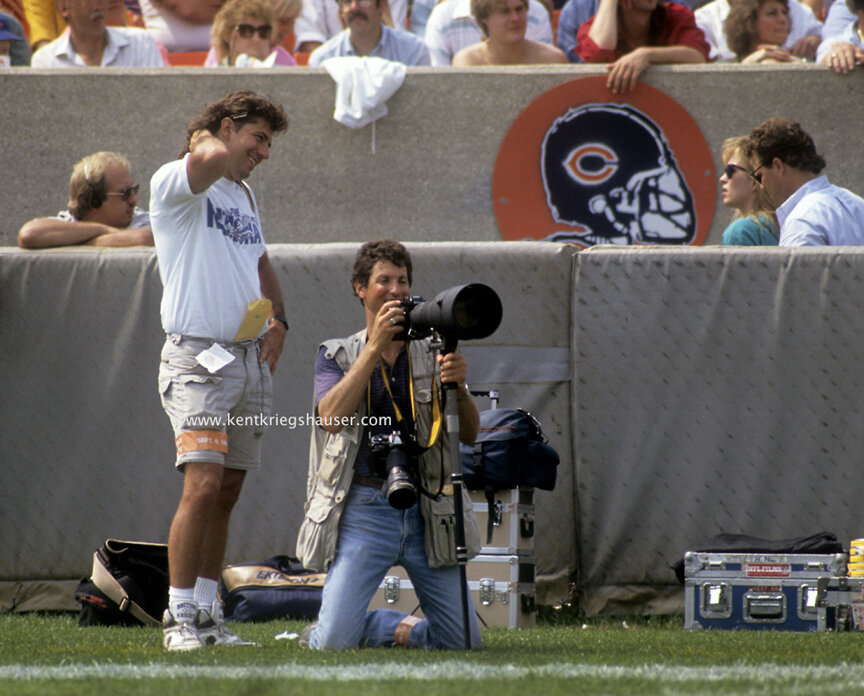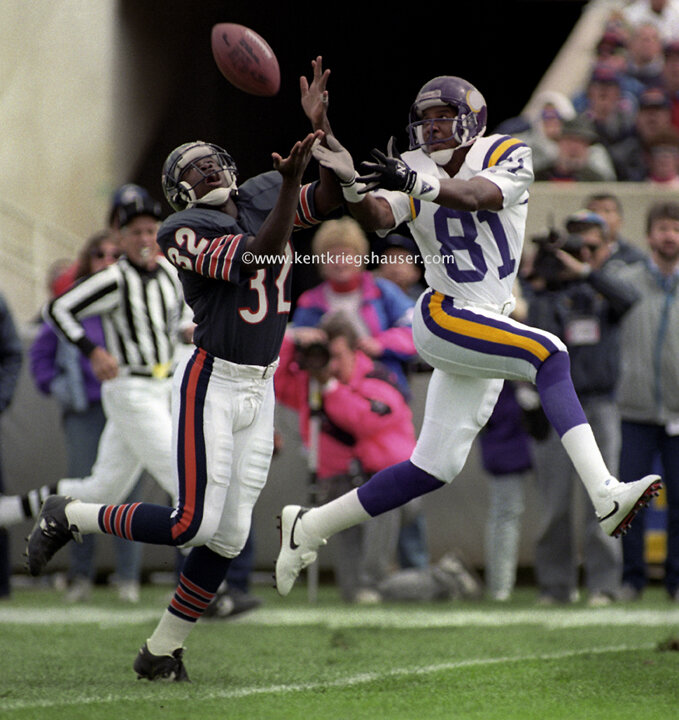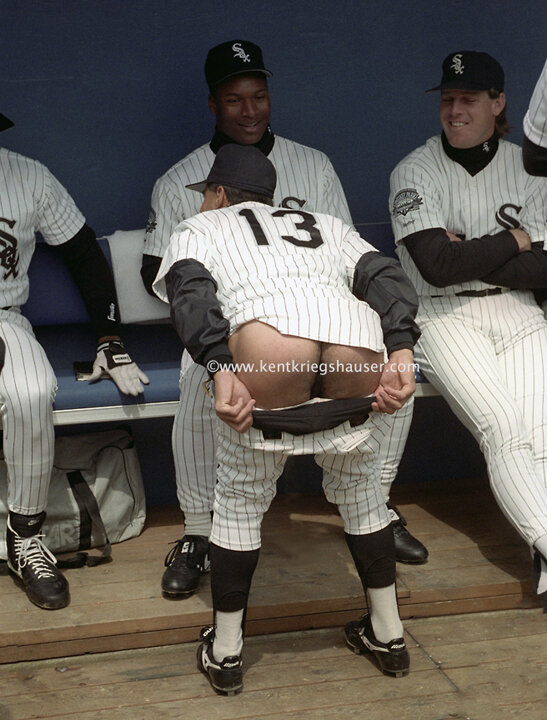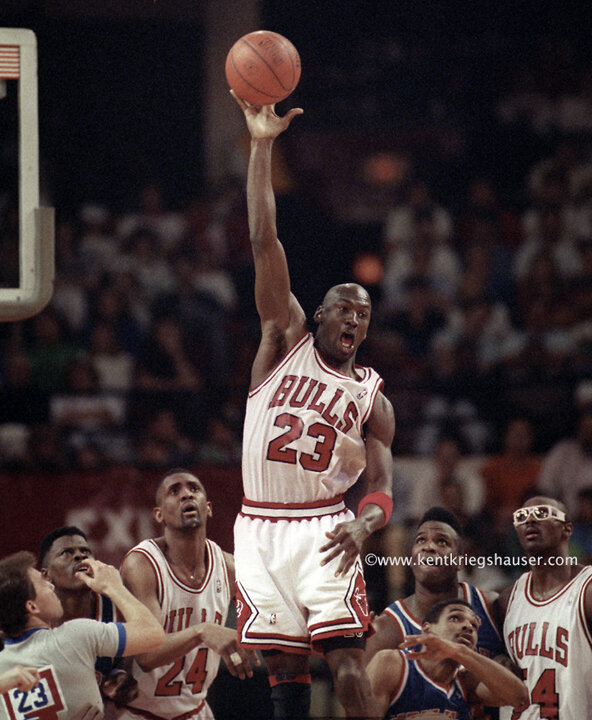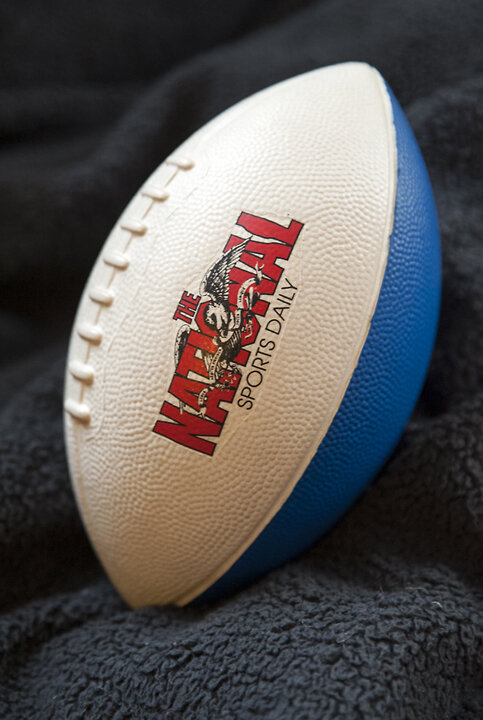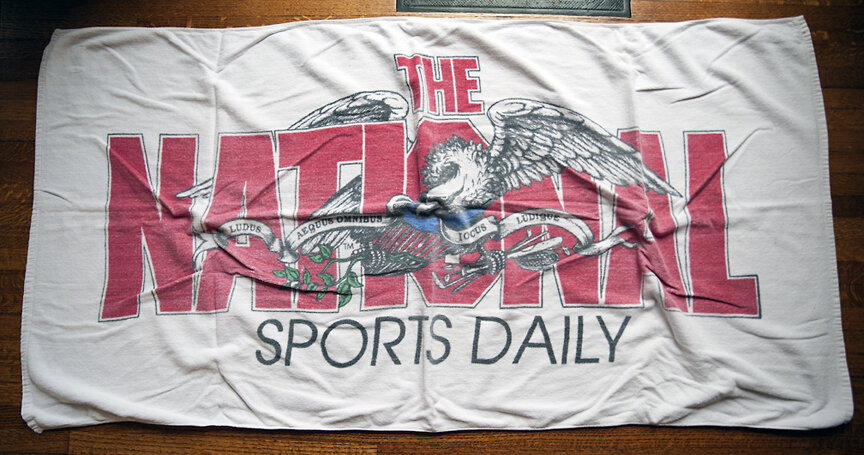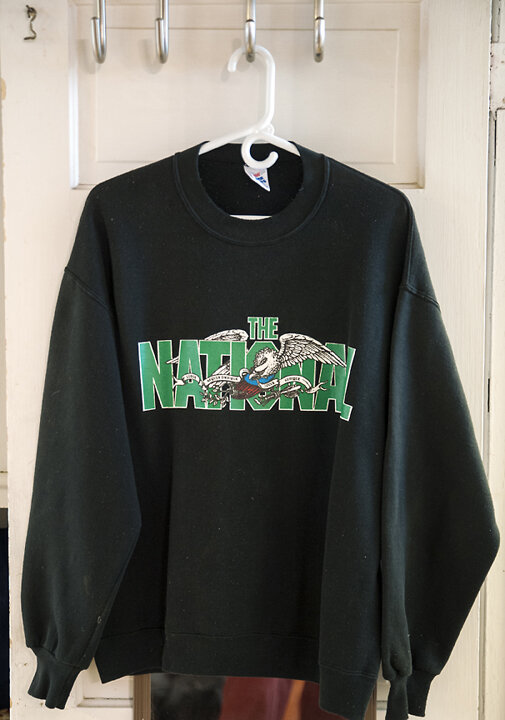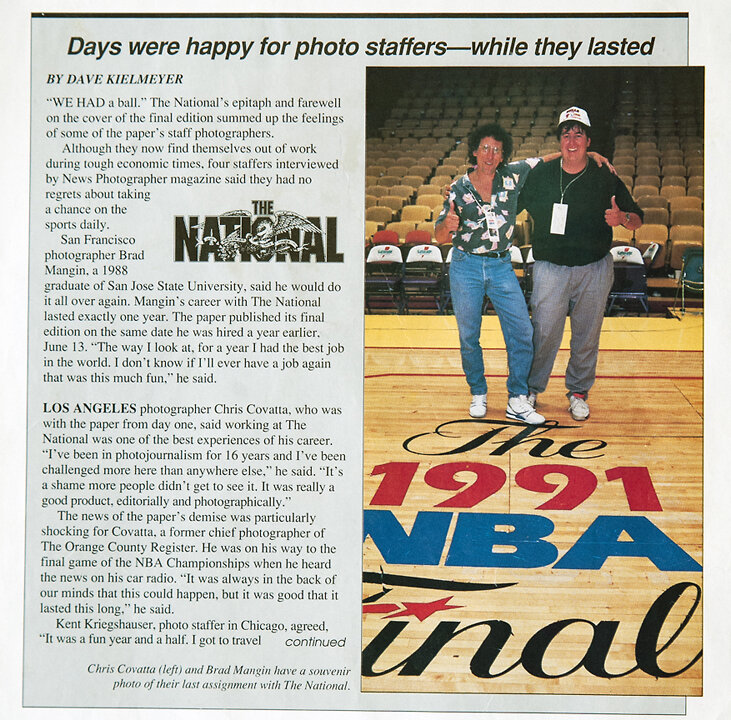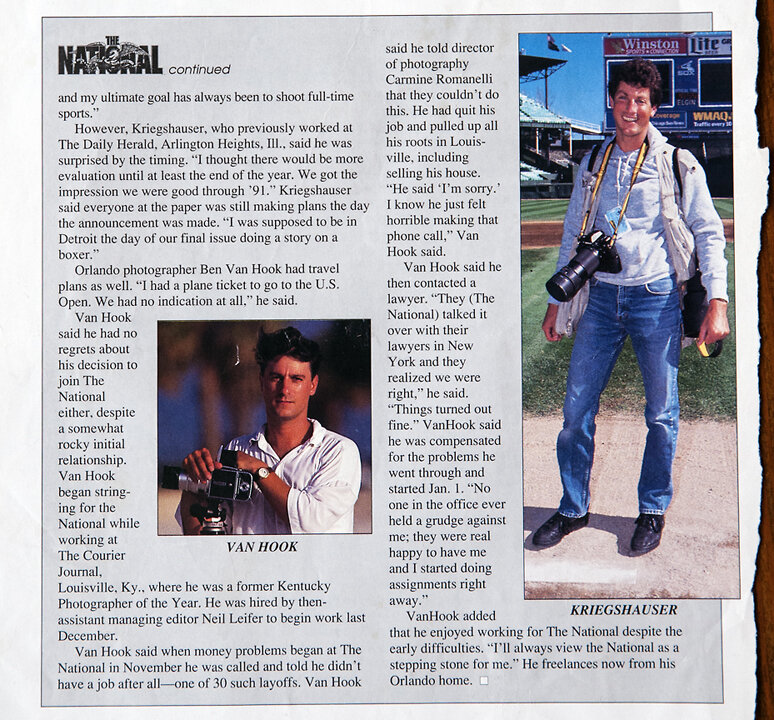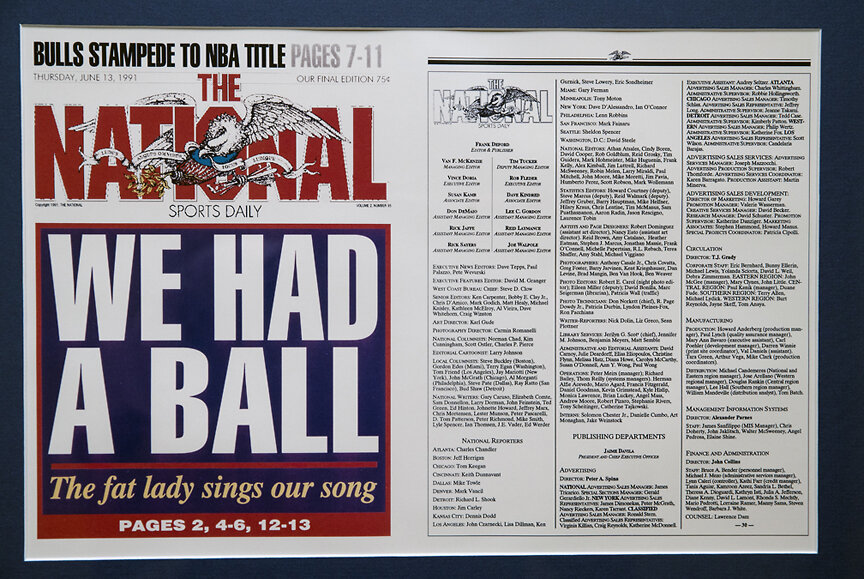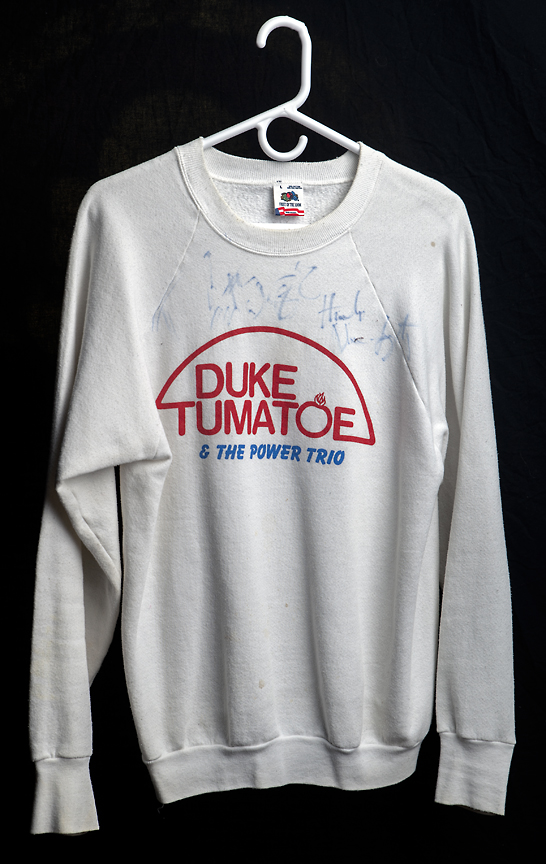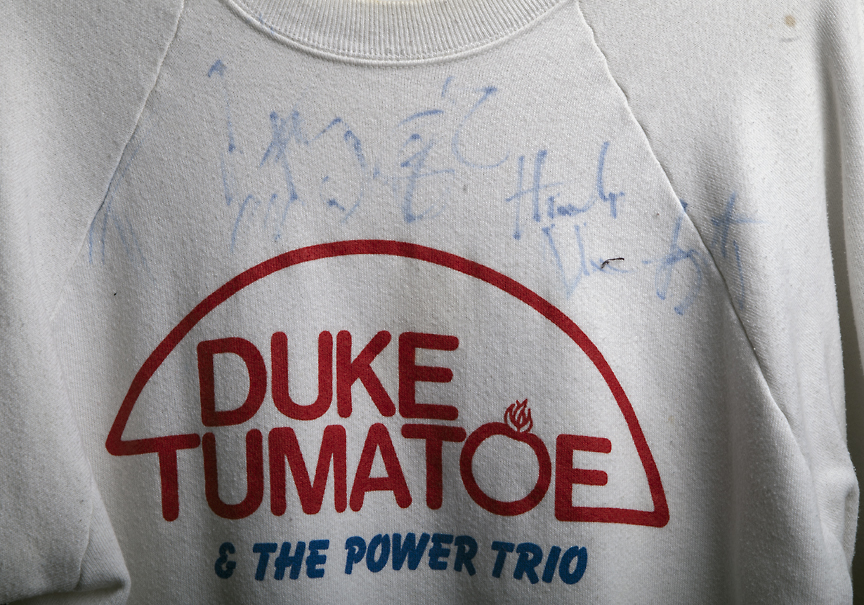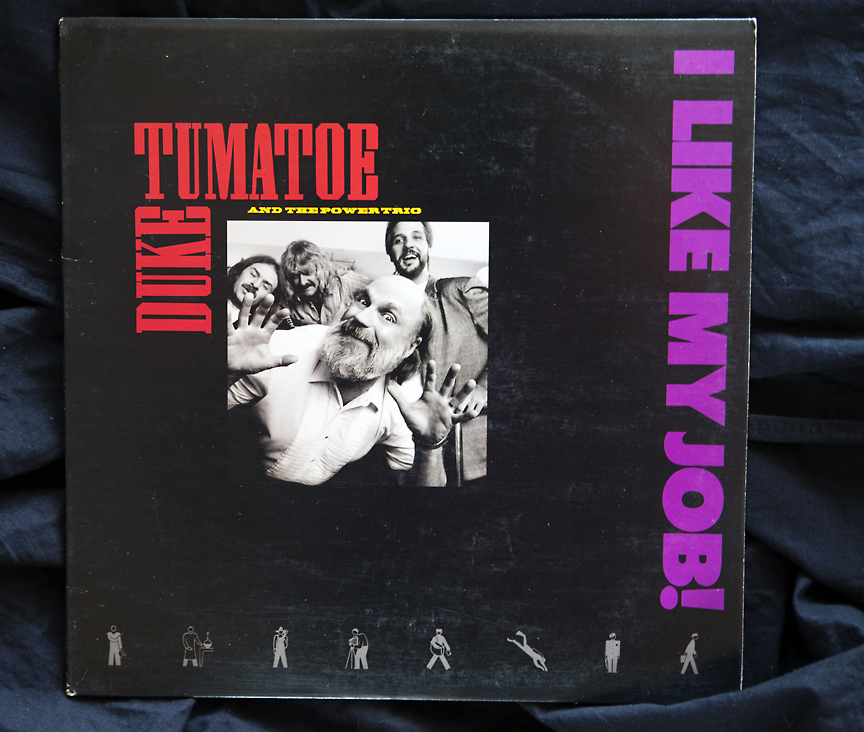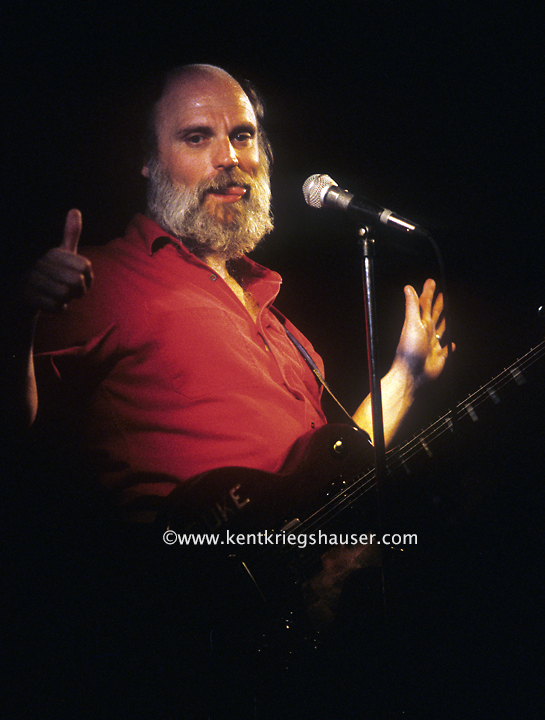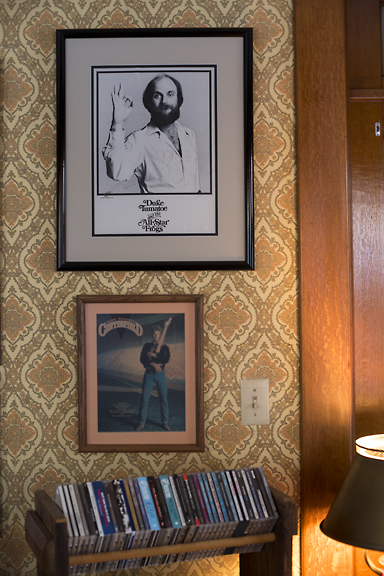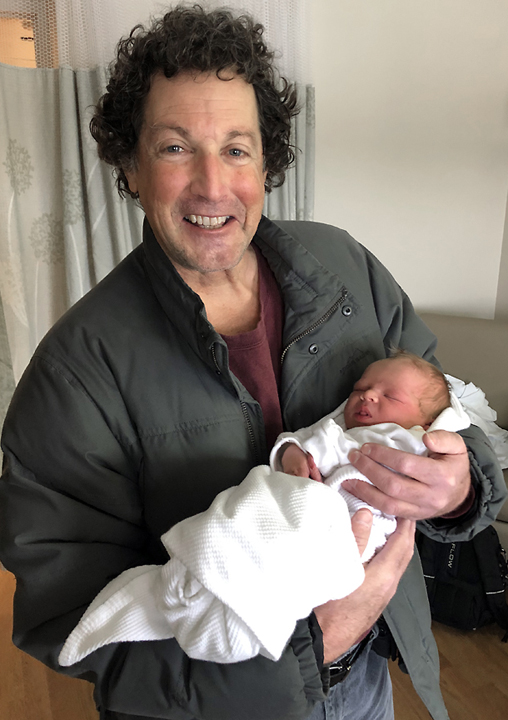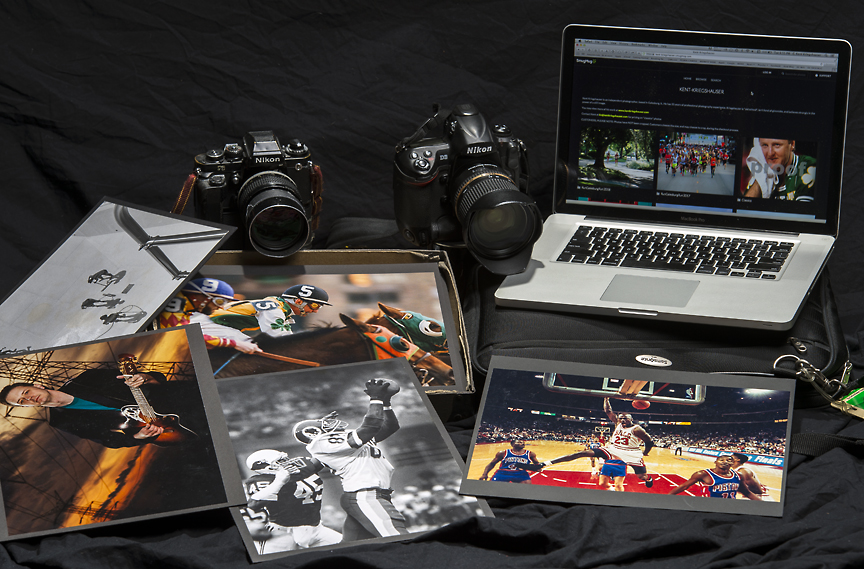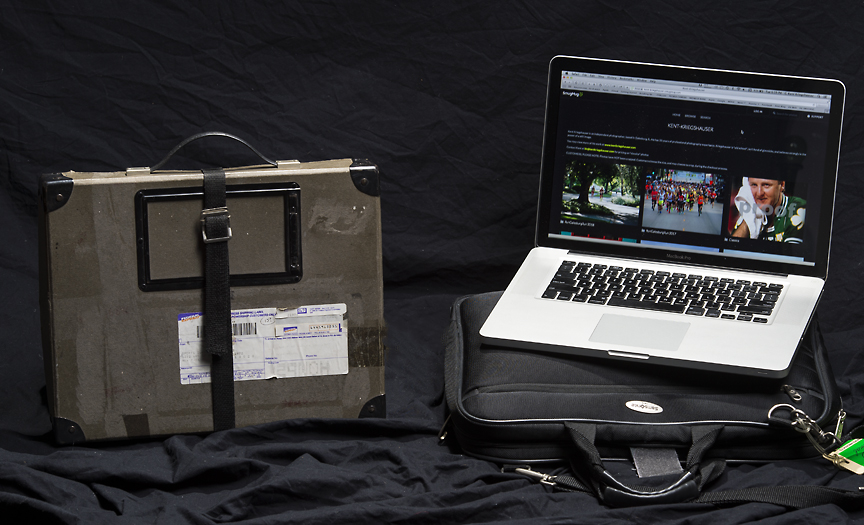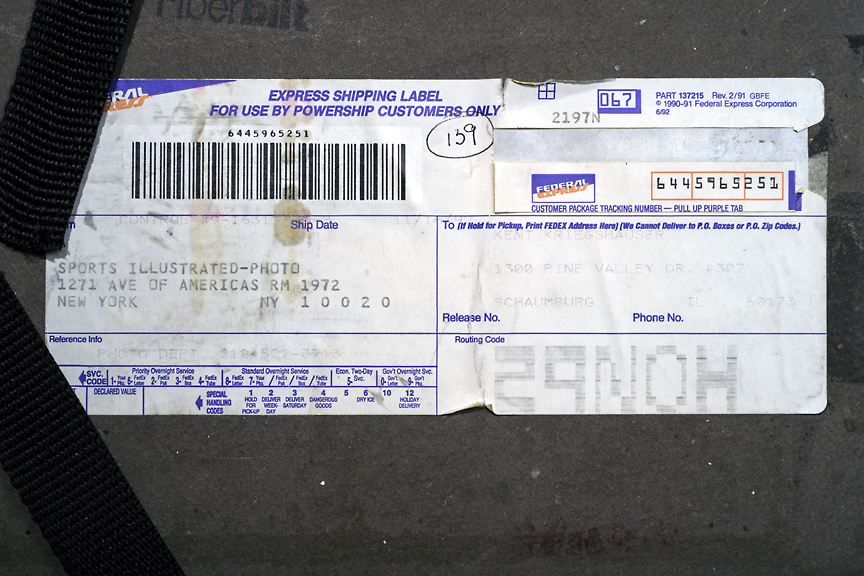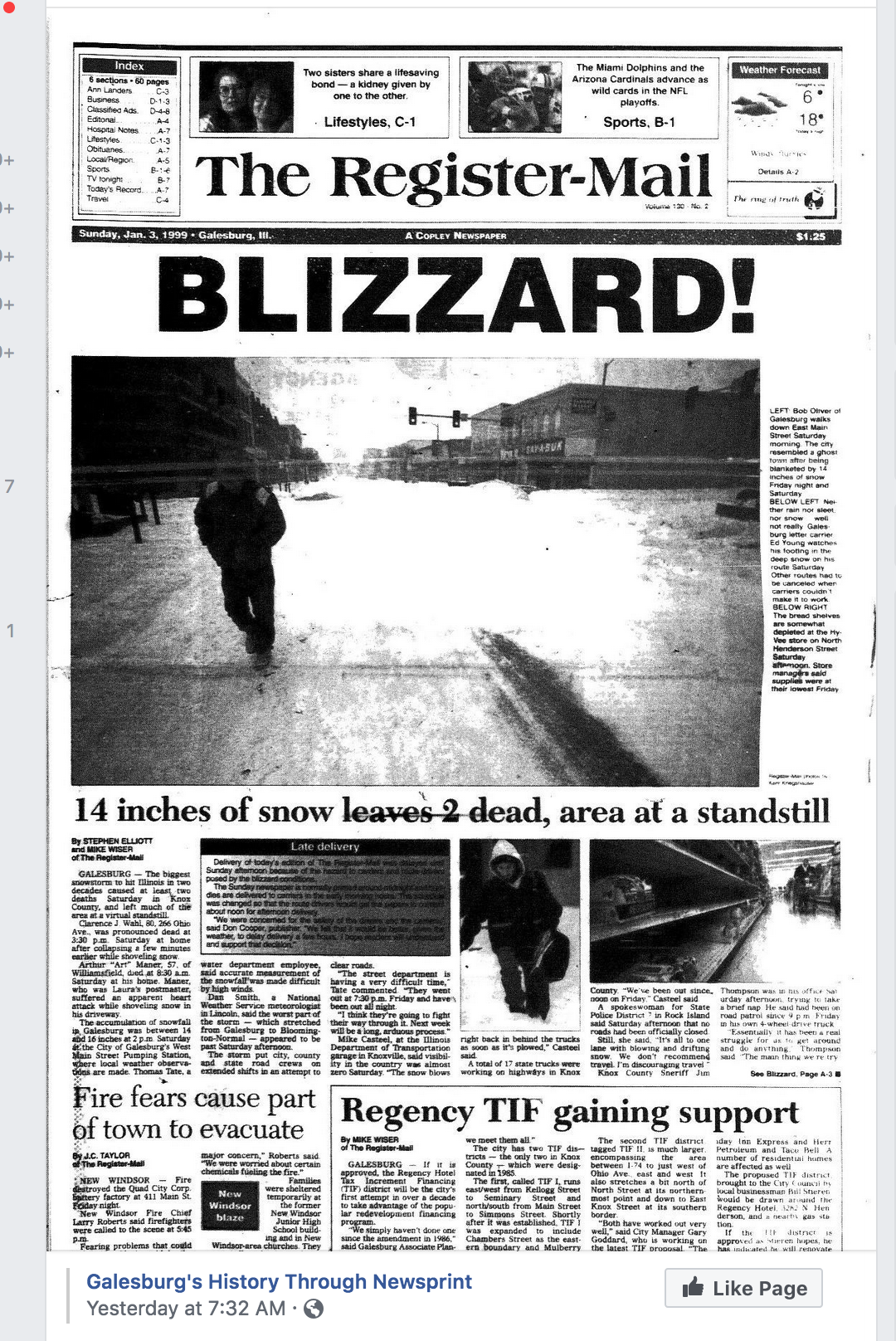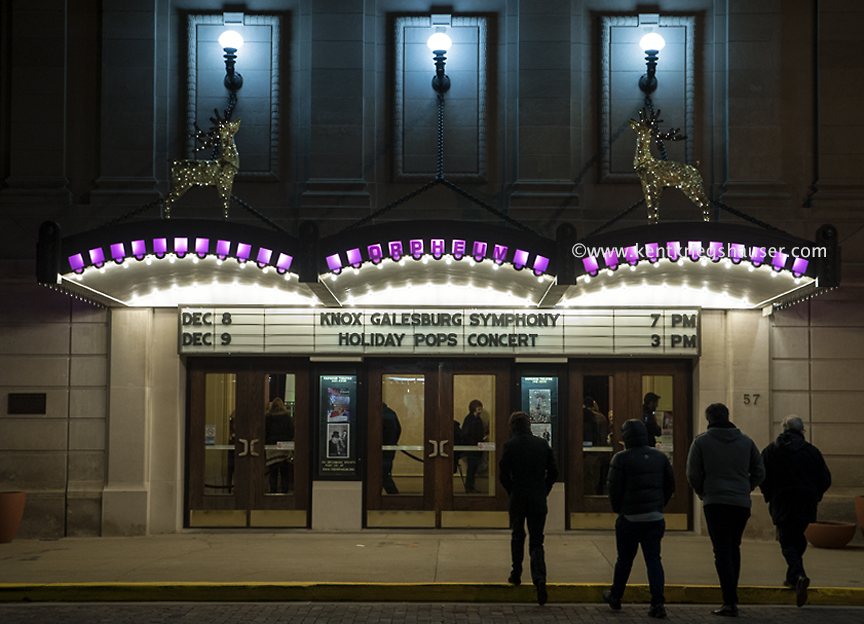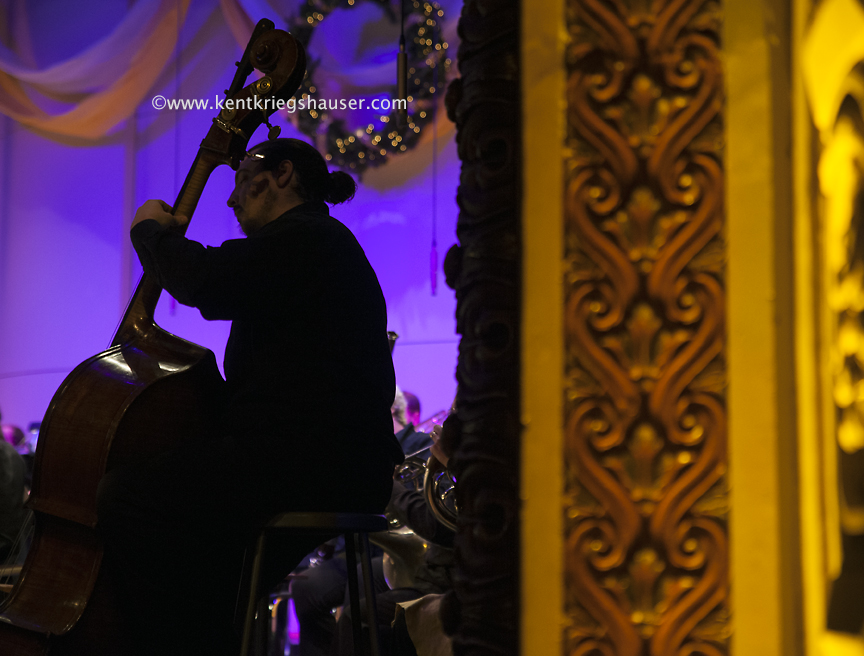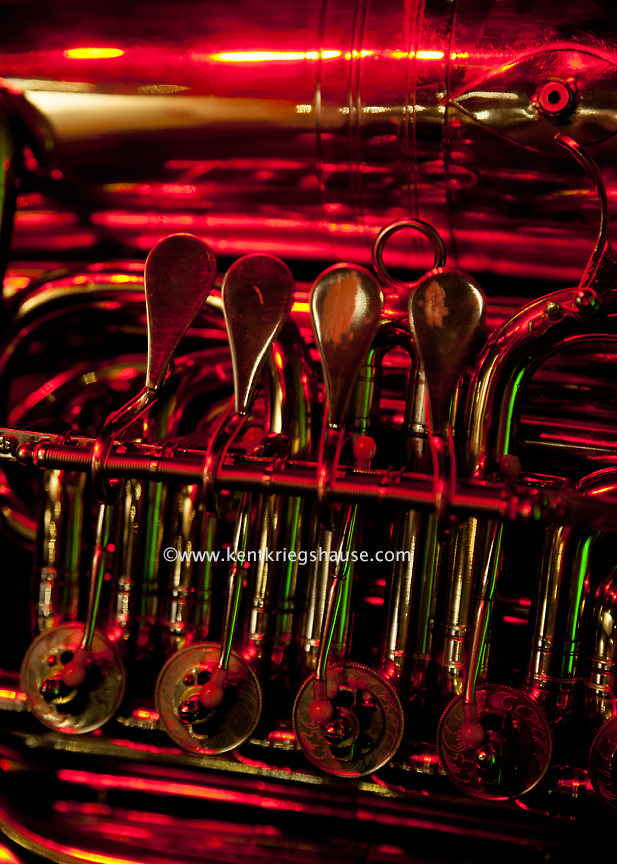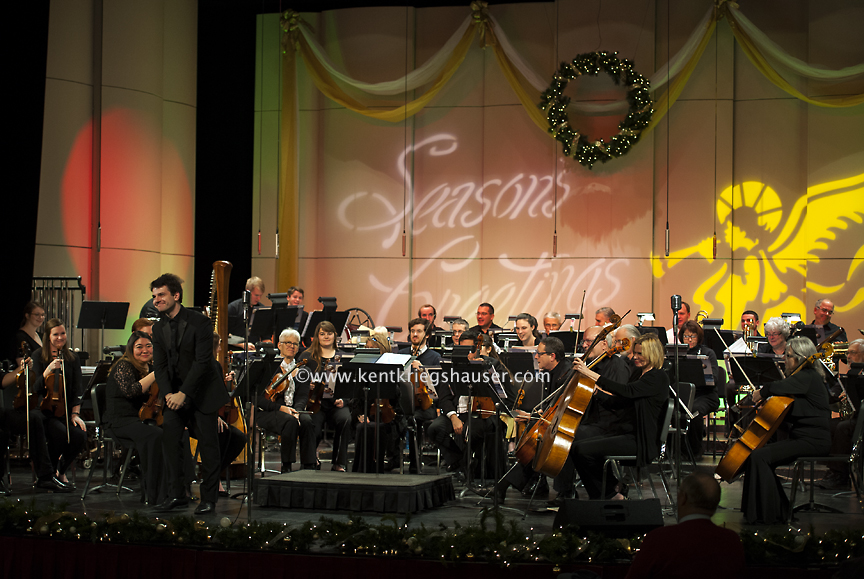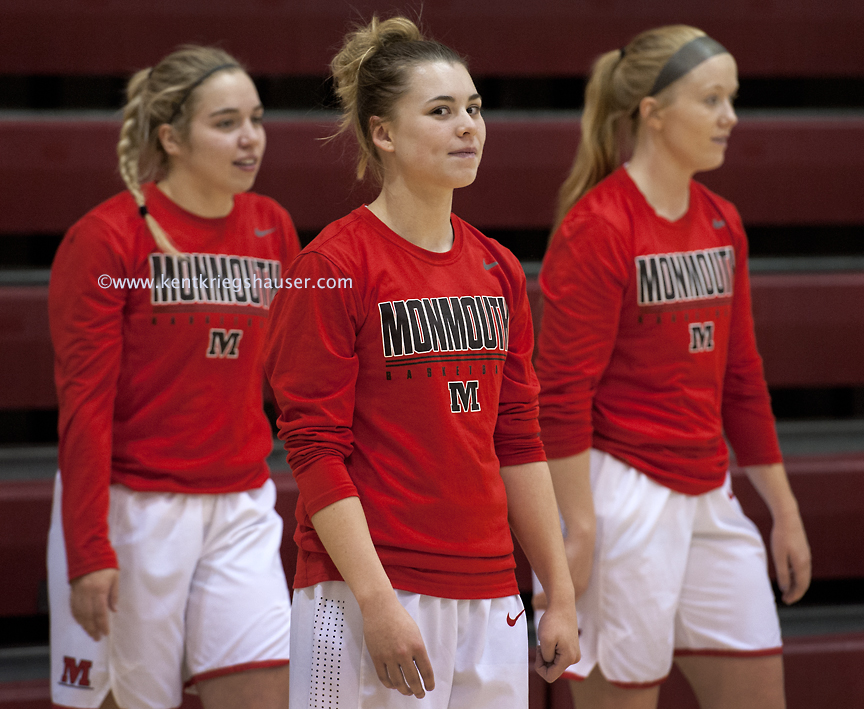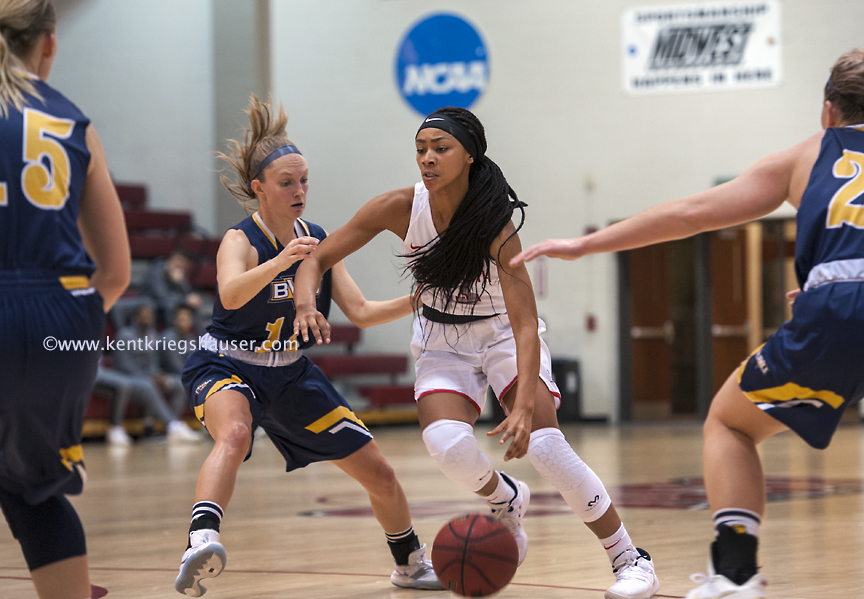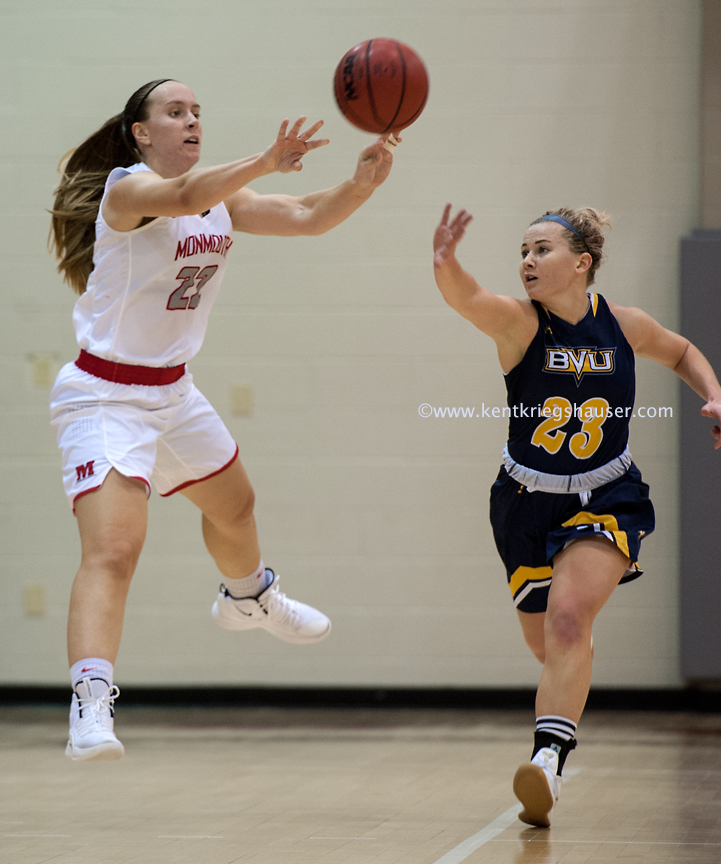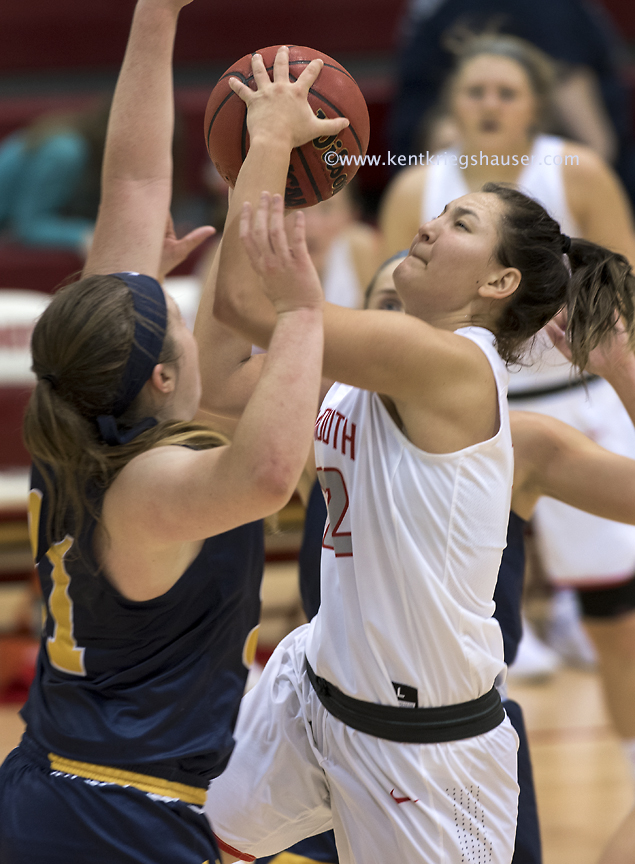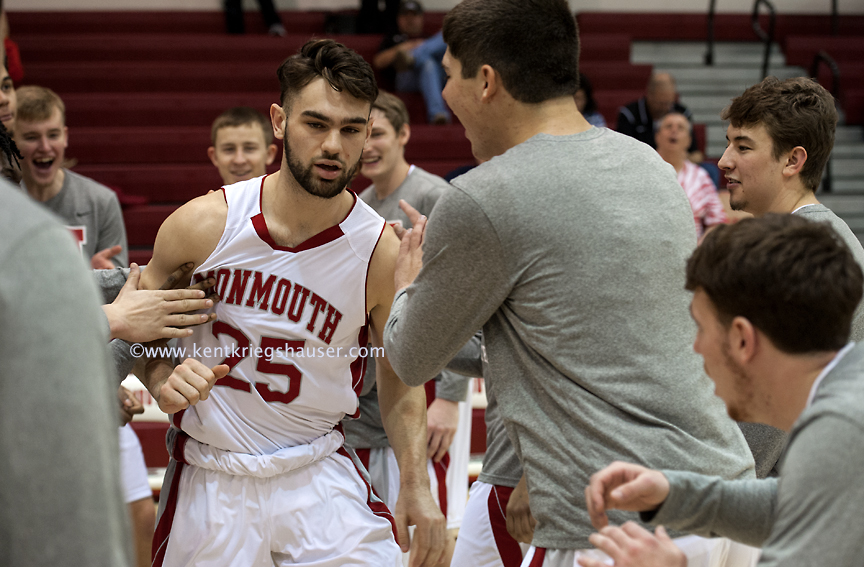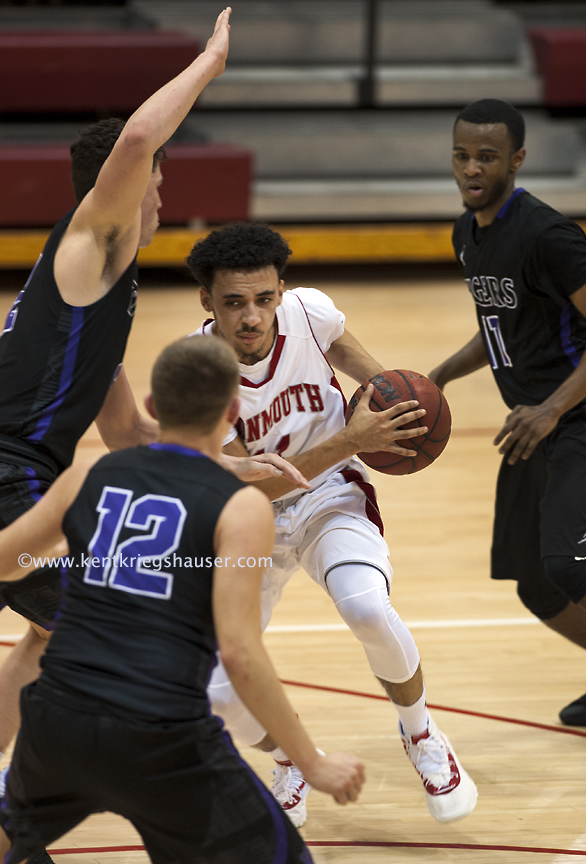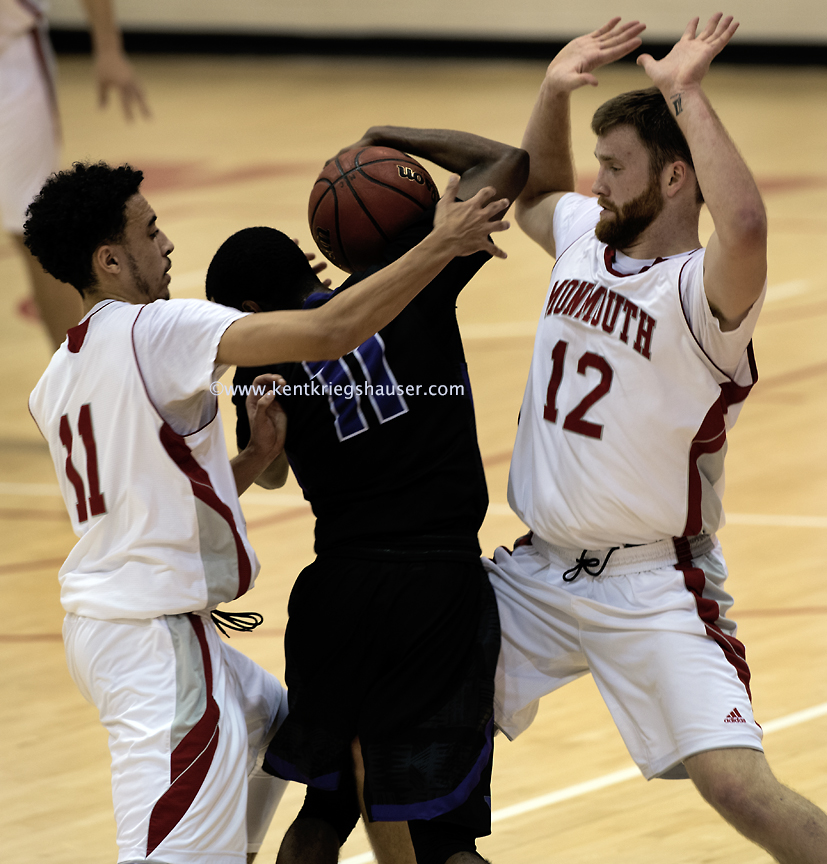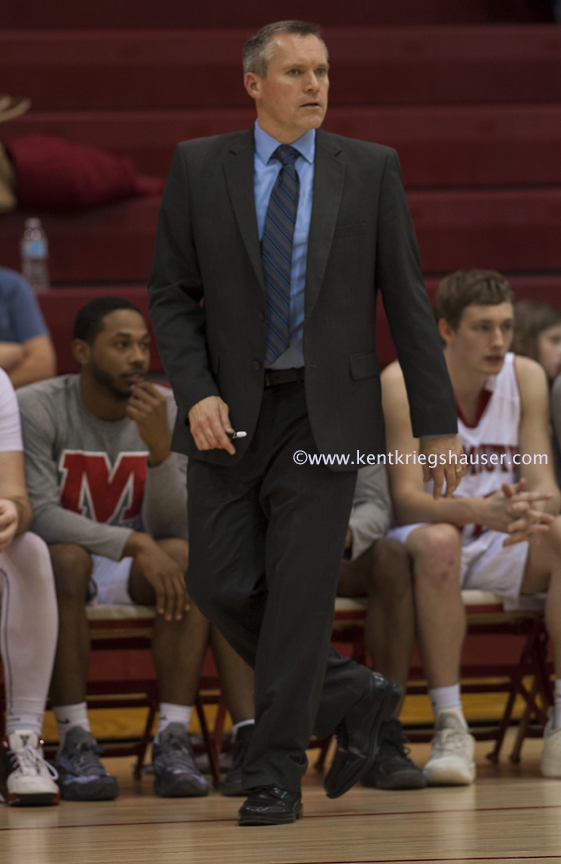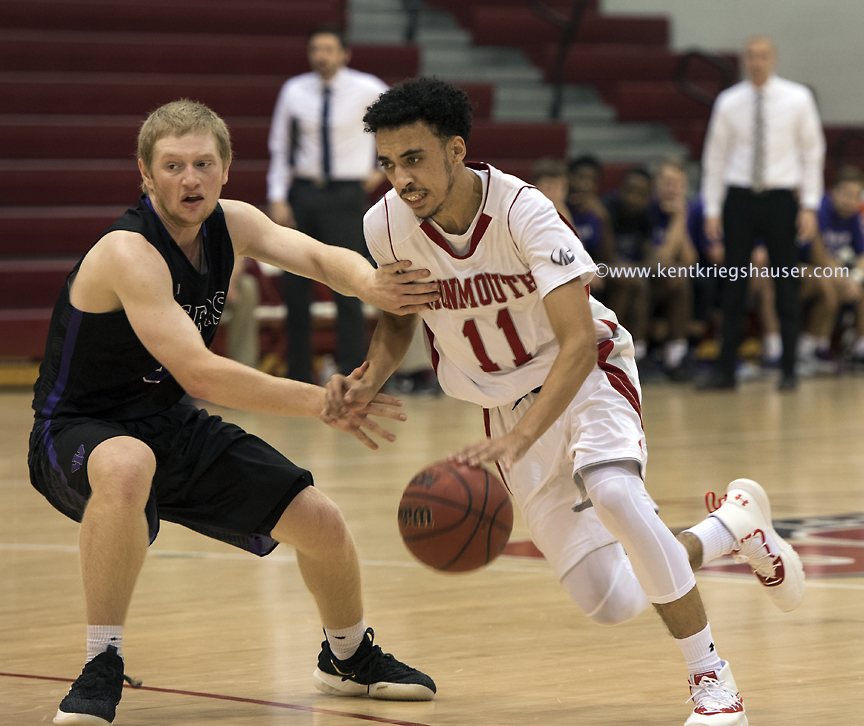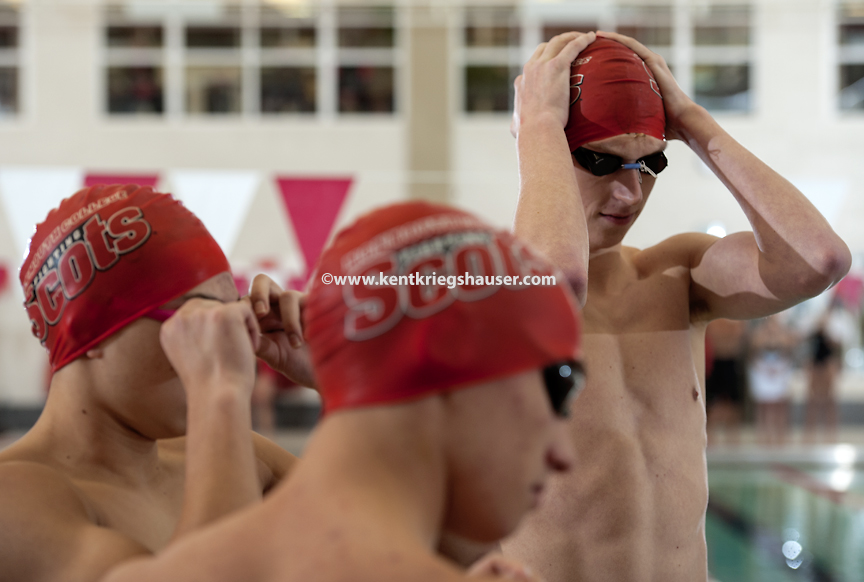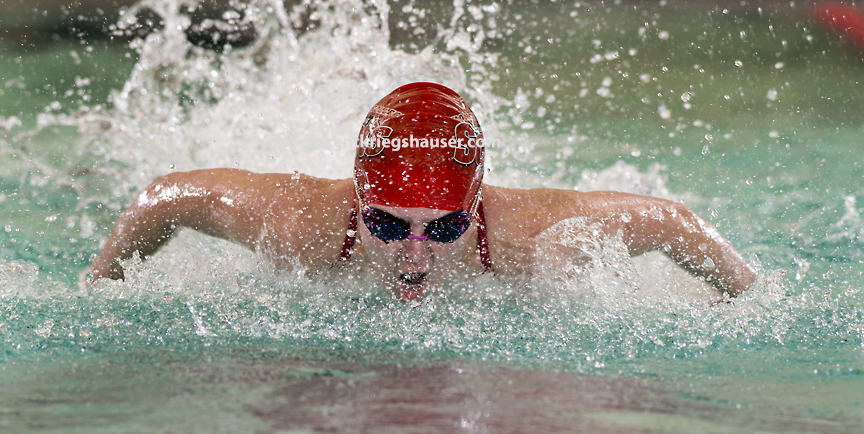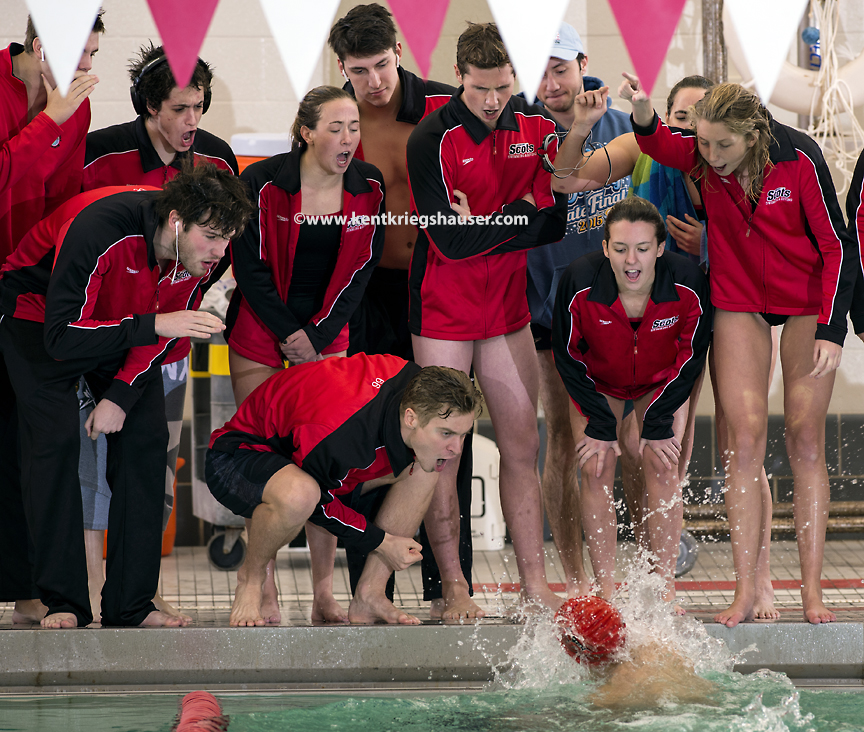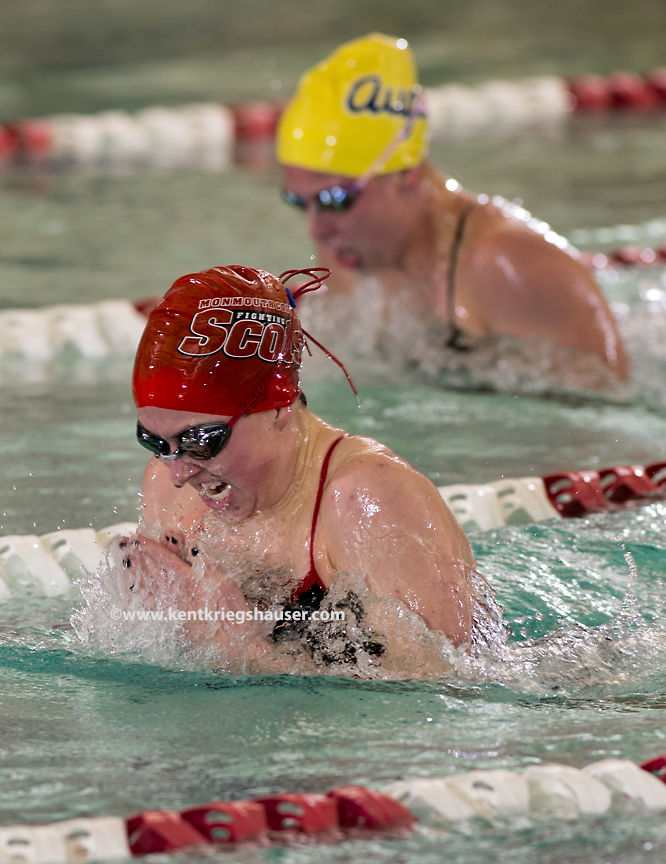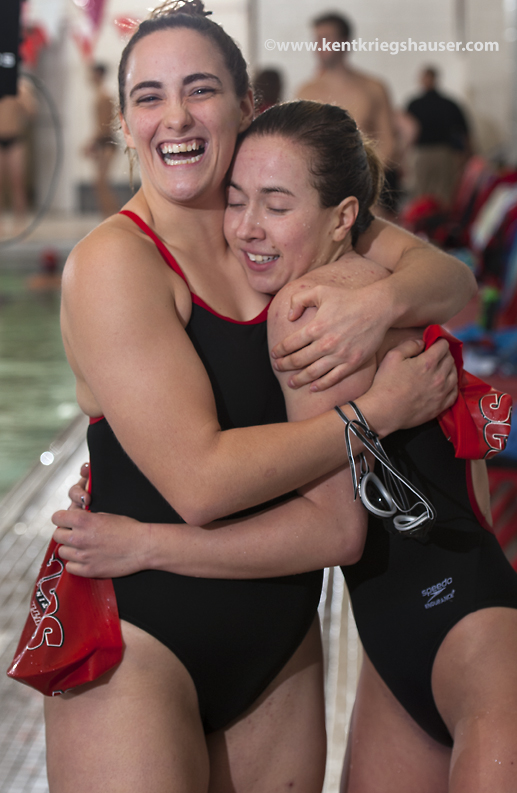Radio ads touting a new sports publication featured the voice of editor & publisher Frank Deford.. “I’ll have a National. Gimme a National!”
The National Sports Daily first published 30 years ago today. January 31st, 1990. The last issue rolled off the presses June 13th, 1991. A short, 16 months and change , run. I was lucky enough to be along for the entire ride as a staff photographer.
Around 1971, as a 12 year old, my “dream job” was to be a photographer for Sports Illustrated. I’d marvel at, and study the photos, then look towards the back of the magazine for the photo credits box. Neil Leifer, Heinz Kluetmeir, and John Biever were three who I felt were some of the best. Back then, photo credits were buried in a small box. The photographer’s name would be listed with any page numbers their photos appeared on. 19 years later, in 1990, I found myself working for Leifer, and occasionally rubbing shoulders with the other two, and many other talented “shooters,” as I photographed college and professional sporting events around the county.
From the summer of 1987 through December of 1989 I was a staff photographer for The Daily Herald in Arlington Heights, IL. I’d moved there from The Macomb Daily Journal. I was pretty happy at The Herald. A fine paper with a great group of photographers.
News of a coming “all sports” paper, that would publish five days a week, and was to launch in late January of 1990, hadn’t reached me. I was not aware of it. And there was little to no talk about it in the photo department at The Herald. One day my phone rang at home. Barry Jarvinen was on the other end. I knew Barry as a staff photographer for The Chicago Sun-Times. I would bump into him from time to time. I tried to converse with Barry one time as we sat along the baseline at a Bulls game. I found him quiet. Now, I wondered what this call was about? “I’m kinda surprised some of you guys haven’t rung me up,” he said. Then he proceeded to tell me he’d left the Sun-Times to become the chief photographer for this new sports paper. He provided specifics, and asked if I’d be interested in becoming the second shooter? “Sure,” I said. An interview was arranged.
The Chicago bureau was located on the 15th floor at 35 East Wacker in downtown Chicago. The Jewelers Building. I drove down sometime in early-mid December, met with Barry and a few others, showed my work, made my pitch, and went home. The prospect of being a full time sports photographer was very appealing. But I was warned that “start up” publications have risks. I didn’t pin my hopes on anything. And I kept my mouth shut at The Herald.
At some point before Christmas, Barry called to say the position had been offered to someone else. I went home to moms, disappointed but not devastated. Mom had gotten me a travel kit as a gift. “It’s too bad I didn’t get that job. This would have been perfect,” I told her.
Sometime very soon after, Barry called again. “The first candidate turned the job down. Are you still interested?” “Can I think about it for a day,” I asked? “Uhhhh, I wouldn’t if I were you,” he replied. “I’ll take it,” I said. Barry explained later that he had been running out of time to get a second photographer on board. He needed a “yes.” from someone. I must have been second on his list. My last day at The Herald was January 8th. “Practice papers” for The National began on January 10th.
The National would publish five days a week from three cities. New York, Chicago, and Los Angeles. New York was the “main base.” Chicago and L.A were bureaus. Events were covered by staff in New York, Chicago, L.A., and other cities, then stories were filed via laptop computers to New York. Photographers would have their film processed, usually by the Associated Press, then transmit photos to New York via a Leafax. More on the “Leaf” later. NYC had a much larger staff. The production took place there. Then, the paper would use a satellite system to transmit laid out pages, etc, back to the other two cities, and printing plants contracted to make the press runs.
There was no plan for home delivery. Sales would come from honor boxes and news stands, and other locations. This was fine in New York, where public transportation stations put the product in front of many commuters. It worked fair in Chicago. In L.A., where everyone drives, and public transportation was almost non-existent, it hurt sales from the beginning.
I’m not sure how The National came about? Sports exclusive papers had been successful in Europe. Surely, sports obsessed Americans would go all in for such a paper?
It is an understatement to say The National was well financed. The columnists, reporters, and other staff were some of the most famous names in sports journalism in the country. Many were plundered from the metro papers in cities across the states. Journalists willing to take a risk on a new product. And extremely well paid for doing so.
Each of the three cities would have two staff photographers. Generally, the plan was to cover local teams, both college and professional. For Barry and myself, that would mean the Bulls, Blackhawks, Cubs, Sox, and Bears. It could also entail Northwestern and DePaul. We would also spend a lot of time in Champaign, South Bend, and Milwaukee. I was excited to learn that one of the L.A. photographers would be Chris Covatta. Chris had worked at the State-Journal Register in Springfield, IL I knew him and loved his work. He was an inspiration to me when I was in high school, studying and learning photojournalism.
For 20 days, we all went and covered live events, sending work to New York as if we were publishing. This was to practice hitting deadlines and working out bugs. The time differences were an issue. 6 p.m. in California is 9 p.m. in the Big Apple. The west coast boys had the largest disadvantage.
All kinds of brand new gear began arriving at suite 1550 in Chicago. Camera bodies, lenses. and all sorts of lighting gear. A film processor was put in place in a room towards the east end of the office. The room beside it was set up with a light table, used to edit film, and a place to set the Leafax.
The Leafax was a portable photo transmitter. Contained in an aluminum suitcase of “standard size”, it was heavy. One would open it, set it up, and power it on. With each use, a strip of film was used to calibrate it. When it was warmed up and ready, photos transmitted via a phone line. The Leaf scanned color negatives and digitized them. The film holder was small. Designed for film to be cut into frames of three. The middle frame was the frame to be sent. Each photo took approximately 25 minutes to send. The Leaf was expensive. It was of carry on size for planes, and that is how we tried to transport it. Fragile too. A solid bump or drop could break something or knock it out of calibration. Even back then, it would often raise eyebrows at airport security. I was asked to open it and power it up more than a few times.
One of my first out of town trips was during the practice period. On January 15th. I was dispatched to Minneapolis to make portraits of former Viking, Karl Kassulke, at his home. The fun of travel was tempered by having to lug gear around. It wasn’t long before I bought a small, foldable pull cart. Barry was more experienced and knew what lie ahead. His advice? “Sign up for every frequent flyer program you can.” Practice was over. We were ready to go live.
And so it began. We were either shooting the local teams, or making regional runs as needed. If we were home, we’d shoot until it was time to head back to the office to process, transmit, and make deadline. I had this routine down from working at The Herald. If we were on the road, the Leaf went with us. The Associated Press would process our film, then we’d work from a table somewhere in the arena or stadium. Conditions in those rooms varied greatly. Some were nice, some were dumps.
Barry and I worked together early on. We hauled four new, huge, Speedotron lights to South Bend to strobe and shoot a Notre Dame basketball game. Each head had four flash tubes, and massive, heavy power packs. We had to drag it all up steps, and position it around the catwalk to the four corners. Then, wire them all together before letting a “drop cord” down to the floor, where it would plug into our cameras to fire the strobes. The process took close to two hours. It all had to be taken down and packed up at the end of the game.
Another South Bend job brought in staff from New York. They had their hands on what was then, almost an unknown. A Sony Mavica digital camera. About the size of a Hasselblad, It shot a floppy disk. I have no recall of the megapixels, etc. The support software that it required transported in a wooden box that barely squeezed into the back of my car. The two technicians, and all the gear flew into Chicago. Then we drove down and shot a Notre Dame vs. Michigan football game with it all. The first game of the season. Other photographers checked us out. Curious but skeptical. I found it difficult to use. But it saved film processing and bought us time.
It was fun, but hard work. Not glamorous. When sports photographers travel, most of the time, they see airports, arenas and stadiums, and hotels. When they are working, they often have the best seat in the house. But they are not enjoying the game. They are there, under pressure, with the expectation of producing fantastic photographs. The games were the tip of the iceberg. Way more hours were spent in preparation, and/or sending photos, long after the games were over and facilities empty of fans.
Spending time with Barry, I got to know him. He was a graduate of the University of Missouri journalism program. One of the best. He was indeed quiet. But easy to get along with. His words were seldom wasted. He pointed out one of the perks of sports photography, as opposed to general photography. “You don’t have to pose anybody. And you don’t have to stop them to get their name.”
Though I never met the vast majority of them, I would chat with the night editors in New York as I sent photos. There were frustrations within the process, but there were no second thoughts about leaving The Herald for the unknown. As a photographer, I was a foot solider, pretty much removed from any discussions as to how the product was being received, how it was selling, etc. In Chicago, I didn’t hear a lot of business talk. Our bureau chief was Bud Shaw, a great guy. The ad sales guys were across the hall from the photo area. They were very professional, had lots of experience, and hustled hard.
The National was definitely ahead of its time. Some say The National “invented” box scores for hockey. The graphics were super, the writers and columnists were too. The photographers… We were all solid action shooters. Chris Covatta was our portrait ace. When needed, we enlisted the help of other well-seasoned shooters.
As fine as the product was. As well as it was being received. At least one major “player” in the sporting world community, gave all of us an “ego check.” The National applied for writing and photography credentials to the 1990 Masters Tournament. They turned us down cold. Something to the effect that we “weren’t proven.”
Any Bulls or Blackhawks game meant a trip to 1800 W. Madison St. Chicago Stadium.was built in 1929. The building had seen better days. It was way outdated, but had so much character. A lot of history. In the fall, photographers would stop in to pick up their photo credentials for the hockey and basketball seasons ahead. Once inside, the place would smell like fresh paint and stale beer. I absolutely loved working in that place! “The madhouse on Madison,” they called it. Blackhawks fans were loyal. And this was right in the middle of the Michael Jordan era for the Bulls.
Photographers parked on Wood Street, then walk west on Warren Street to the west end of the stadium. At the west end was a fenced in parking lot for players and team staff. Open air, nothing fancy. A security guard kept watch on this gate. I got my first look at a Ferrari Testarossa in that lot. A guy named Jordan owned and drove it. Walk though the lot and you’re ready to enter the building at gate 3 1/2. An Andy Frain usher would hand you a circle sticker that identified you as being allowed to work the event for that night. Peel off the backing, slap it on your jeans, and walk on into the arena.
The National had a deal with Blackhawks photographer, Sal Benjamin. We rented two of the big strobes, mounted up in the rafters. This arrangement saved us from having to install and remove all that equipment on a regular basis. Those lights were triggered with a wireless system. The transmitter plugged into a camera socket. When the shutter was tripped, the signal fired the lights.
A hockey rink is larger than a basketball court. Depending on which we were shooting, Barry or myself would have to go to the electricians room and get a key from Gene. The key got us though a door that gave us access to the catwalk system, 90 feet above the ice or floor. In 1929 they didn’t put elevators in sports arenas. We would trudge up many flights of steps near the southwest corner of the building. Once the door to the catwalk was opened, you were hit with big gust of air. The massive catwalk system was dark and dusty. Some of the railings were suspect. Looking down would make your palms sweat.
We were up there on a regular basis. Why, you ask? Because of the difference in size between that ice and wood, the lights and reflectors had to be re-positioned, ever so slightly, to re-aim the best light on either the backboard and net, or the hockey net. If it was a hockey game, you weren’t alone up there. Chicago Stadium had a massive organ. The pipe system was in the rafters and catwalk. A guy was stationed up there on a concrete pad, to trouble shoot and free any organ valves that might stick open. He read a lot of books to pass time.
In the summer of 1990, I was sent out to Seattle to photograph the Goodwill Games. The games were the idea of Ted Turner, in reaction to political troubles surrounding the Olympics. The 1990 games were the second edition. The games were very, very much like the Olympics. I was paired with L.A. staffer Michael Goulding. Mike is super-talented. We worked as a team, and we had a young man, Eric, who did some of our film running and transmitting. He was a friend of Carmin Romanelli, our Director of Photography, in New York.
We did the best we could. And that was really good. But, as made for television, many of the major events did not begin until mid-evening. With that three hour time difference we were behind the eight ball a lot. Deadlines were murder out there.
Being at the games for around two weeks, this was one place where we did have some down time. A chance to roam around Seattle. Mike introduced me to my first iced coffee at some outdoor cafe along the harbor front.
Everything seemed to be rolling along fine. We were six months into it. If there was any cause for concern, it was well guarded. More bureaus were opened. Atlanta, Detroit, San Francisco. With each bureau, more staff. Including photographers. When a bureau opened in Washington D.C., Barry and his wife Leslie headed east to run it. I was now going it alone in Chicago. Eventually, there was a shift in how we approached the photography. More emphasis was put on portraits and feature stories. A little less on trying to keep up with game action.
When I did shoot action, I was granted the luxury of having someone be at the office to transmit photos while I stayed longer at games. More time meant more opportunity for better photos. We had made arrangements with a courier company to meet at a specific gate at a specific time. I’d leave the action for a few minutes, run the film out to the waiting car, and head back to the photo position. The courier would drop the film with our “transmitter person” in the lobby of 35 East Wacker. It was a good move. Barry’s friend, Cathy, and my friend Mark, were often used in this capacity.
Cathy provided me with one of the best memories during my tenure at The National. I was shooting a night game at Wrigley. Cubs vs. Dodgers. I’d loaded with high speed film, but it was still twilight when there was a play at the plate. I had no idea what I got from it (no reviewing in the Before Digital days. You had it or didn’t). The play was on film I sent with the courier. I shot the rest of the game and drove back to the office.
Cathy had sent photos to New York and had gone home. The office was dark. I flipped on lights to find “footprints” leading back to the room we transmitted from. She had taken her shoes and made multiple photo copies of each one, left and right. Then she went to the trouble of cutting them out and placing them on the hallway floor to look like footprints. Randomly, on different “feet,” she had written words. “This……. way….. to……the…..greatest….baseball….photo…..EVER!”
I had made a pretty good photo of the play at the plate. Helmets flying off, the bat on the ground, the ball. Cathy really went out of her way on that one.
The National had made it a year. Another “start up” publication, the St. Louis Sun, didn’t do near as well. It launched in September of 1989 and was dead by April of 1990. I had worked with a Sun photographer when covering Blackhawks vs. Blues games at The Arena in St. Louis. One night he was there. Soon after, he wasn’t.
When did issues really arise for The National? I think it was a slow process. The pockets were deep. No expense was spared. At least early on. I’d be sent to Minnesota to shoot one game in a series between the Blackhawks and North Stars. Shoot the game, fly home, shoot a game in Chicago, then fly back to Minneapolis for the next game. Those mid-week, round-trip flights could easily cost the company $700 and up.
With no home delivery, everything relied on street sales. The cost of the paper was increased by a quarter, to seventy five cents an issue. “Why is your paper committing suicide,” a photographer from the Associated Press, asked?
The product was great. the logistics were poor. It was not well thought out in the beginning. Looking back, I believe some big names with big egos developed some kind of an axe to grind with Sports Illustrated.. The National was their “we’ll show them” product. In due time, they found out there is a huge difference between publishing a weekly magazine and a five days a week newspaper. I could be completely wrong.
On June 13th, 1991 I drove to Hinsdale, IL to make photos of Eric Soderholm. Soderholm had played for the White Sox, was retired, and was running a ticket broker business from his home. I made my photos and headed back to the office. Our Administrative Supervisor, Jeanne Takami, caught me just inside the door. “No need for you to process that film. We won’t be needing those photos,” she said. I asked why? “Today was our last issue” she responded. I’m not a smoker. I asked Jeanne for one of her cigarettes.
That was it. The National Sports Daily was done and we were all out jobs. No one in our Chicago office said they saw it coming. Not in “sudden death” form.
Reports vary. Some show we spent as much as $200 million dollars in those 16 months.
By luck, a Daily Herald photographer was leaving to move to St. Louis. I wasn’t out of work long. The Herald brought me back and put me to work in a bureau in Lisle. One day, at Wrigley, John Biever approached me. He asked how I was doing and where was I working? I explained I was back in general newspaper photography. “That’s too bad. You are a good photographer.” That felt good. I guy looked up to when I was 12 years old, paying me a compliment.
When everything settled out, many or most of our staff landed on their feet. I don’t know the fate or whereabouts of everyone. But most found work soon again in journalism. I keep in touch with some of them . At times I felt myself harboring mild resentment towards the reckless spending that I perceived at times. Still, I’d do it all over again.
It was pretty close to that dream job.
BELOW ARE SOME NOTABLE OR MEMORABLE ASSIGNMENTS I PHOTOGRAPHED DURING MY TIME WITH THE NATIONAL SPORTS DAILY.
1 1990 Chicago White Sox Spring training camp. Sarasota, FL
2 The 1990 NBA Finals. Portland vs. Detroit. June 5th-14th, 1990. I shot the games at The Palace in Auburn Hills, MI.
3 The 1990 U.S. Open. June 14th-18th at Medinah Country Club. Hale Irwin sinks a 45 foot putt on the 18th hole to tie Mike Donald and send the tournament into an 18 hole playoff the next day. Still tied after 18, Irwin finally wins on hole #1, the 19th playoff hole.
4 The 1990 MLB All-Star game at Wrigley Field. July 10th, 1990. Joe Dimaggio makes an appearance prior to the “Old Timers” game.
5 The 1990 Goodwill Games in Seattle and Tacoma, WA.
6 Notre Dame football. I photographed every home game in South Bend during the fall of 1990.
7 The final White Sox game at Comiskey Park. Sunday, September 30th, 1990. The White Sox defeated the Seattle Mariners, 2-1
8 The 1990 MLB National League playoffs. Cincinnati vs. Pittsburgh. Barry shot the Pittsburgh games. I shot the Cincinnati games along with fellow New York staff photographer, Frank Becerra. Al Tielmans, a free-lancer, also helped out on at least one of these games. I shot the Friday, October 5th game at Riverfront Stadium, stayed the night, then flew to Columbus to work the Ohio State vs. Illinois football game on Saturday the 6th. Illinois won that game, 31-20. I got a shot of Illinois coach John Mackovic blowing a kiss to the Illinois fans. My work that day, drew praise from Neil Leifer, during a phone conversation after the game. “You’re good at this football. You’ve done this stuff before.”
9 Packers vs. Vikings. October 28th, 1990. This game was memorable because it was played at County Stadium in Milwaukee. The Packers played a few games per season at the baseball stadium back then. It was the last example I can think of where BOTH team benches were on the same side of the field. This was great for photographers, as we had one entire sideline to roam. Plenty of elbow room. The Packers won, 24-10.
10 Bears vs. Broncos in Denver, at old Mile High Stadium. Worked this game on Sunday, November 18th, 1990. Then, spent the night and worked a Nuggets vs. Lakers NBA game at McNichols Arena on Monday the 19th. Mile High and McNichols are long gone now.
11 Bears vs. Chiefs on Saturday, December 29th, 1990 at Soldier Field. Damp and chilly. Normally, I’d shoot the game and go home. Instead, I headed straight to the airport to fly to Atlanta. Worked the Falcons vs. Cowboys game on Sunday, December 30th, 1990 on the red clay of Fulton County Stadium. The day before was cold, and I was sick with a cold. Warm enough in Atlanta to shoot this game in a T-shirt. Fulton County Stadium is gone now, too.
12 The 1991 NHL All-Star game at Chicago Stadium. Saturday, January 19th, 1991. Operation Desert Storm was three days old. When Wayne Mesmer sang The National Anthem at any Blackhawks game, it was something to behold and listen to! This time, with emotions and patriotism running at a fever pitch, it was surreal. When Chicago Stadium was no more, there was a story about the “top ten most memorable or historic moments” for the building. The anthem at the all-star game was one of them.
13 The 1991 AFC Championship game. Sunday, January 20th, 1991. With the hockey all-star game the day before, I don’t remember whether I caught a late flight on Saturday night? Or an early flight on Sunday morning? I do know that I was in Buffalo to photograph the Bills dismantle the Oakland Raiders, 51-3. The Bills were using their “no huddle offense.” I shot from the Raiders side and remember making eye contact with one of the players. There was absolute bewilderment in his eyes. There were four of us photographers for this game, Barry and myself from Chicago. Frank and Tony from New York. Carmin did the editing. My day behind the lens was like that of the Raiders on the field. I sucked.
14 Bo Jackson signs with the Chicago White Sox. Jackson signed on as a free agent on April 3rd, 1991. I’m not sure when he played his first game,? Likely, the home-opener I shot, but there was a ton of media hoopla surrounding it. A bunch of us (television and newspaper people) were standing around the dugout at Comiskey Park. I think it was prior to a game, but a few hours before. The stadium was empty of fans. A bunch of players, including Jackson, sat in the dugout, joking and talking. Ozzie Guillen, always the clown, may not have liked the attention Jackson was receiving. In an instant, and in an incident that lasted 3-4 seconds, Ozzie turned his back to us, dropped his pants and mooned us! I was in the right spot at the right time. Reacted quick enough to get the shot, with Jackson and Ken Patterson in the background. The photo could not be published for obvious reasons. I’ve never seen any other still photos of this one. I believe I have an exclusive with this one.
15 The first White Sox game at “new” Comiskey Park. Thursday, April 18th, 1991. The Sox played the Detroit Tigers and lost to them, 16-0.
16 The 1991 Memorial Tournament in Dublin, OH May 16th-19th, 1991. I followed golfer Mike Donald on Saturday and Sunday for a feature story called “The Last Great Shot.” Donald was an unknown golfer who had come so close to winning the 1990 U.S. Open that I’d covered. I made action photos and a couple of portraits of Mr. Donald. He was super cooperative.
17 The 1991 NBA Finals. Chicago vs. Los Angles. June 6th-12th. Barry and I shot the Chicago games. Chris and Brad did the games at The Forum. The Bulls won the title on June 12th after five games. The National Sports Daily was done the next day.





